Writing without data is like driving with a blindfold over your eyes. You’re using guesswork to choose topics and write content but it doesn’t hit the mark or achieve ROI, because it’s not based on data.
Good writers don’t rely on guesswork. You use data from SEO content writing tools to:
- Understand search intent
- Determine which keywords to use
- How to structure the content
- What to say to the reader
- How long the content should be
If you’re a new writer, editor or content manager looking for software to improve your workflow, I’ve compiled a list of content tools to help you at each stage of the content creation process:
- Keyword research
- Creating a content brief
- Writing content
- Editing content
- Optimizing content
To be clear, the opinions I’ve expressed in this article are based on my experience with the use of these tools. I tried to maintain an objective view for the most part (except for Microsoft Word).
Let’s dive in!
Keyword Research Tools
Keywords Everywhere
Keywords Everywhere is a great starting point if you’re only doing keyword research for one piece of content. You don’t need to spend over $100 on keyword research tools when you can get what you need with $10.
Install the Google Chrome Extension, buy $10 credit, and start searching. The best part about Keywords Everywhere is that it shows all the information on SERP.

At the top of the SERPs, you get an overview of monthly search volume, cost per click, competition, and trends for the keyword. On the right-hand side of the SERPs, there’s more information on:
Related Keywords
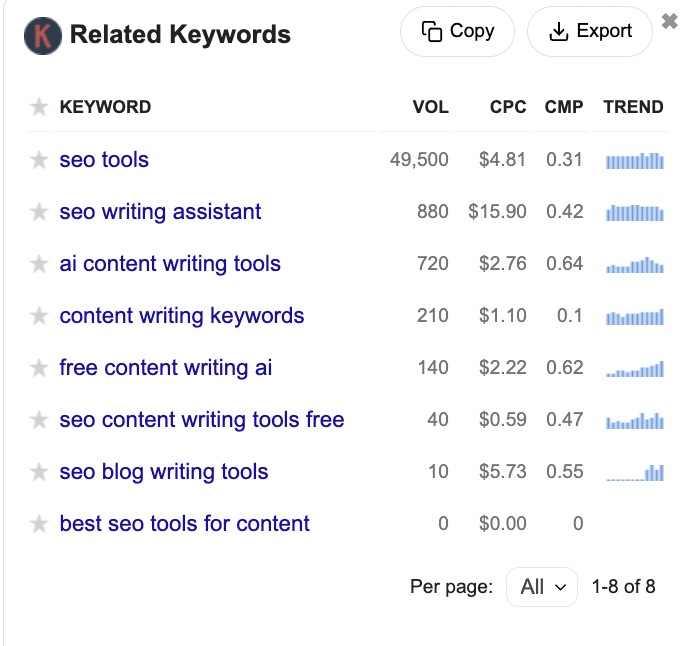
People Also Search For
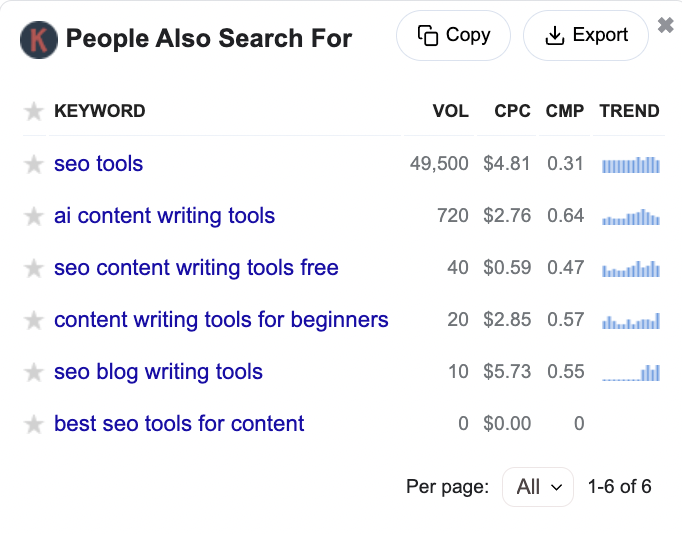
Long-Tail Keywords

Keywords Everywhere pricing
Keywords Everywhere operates a pay-as-you-go model. I bought 100,000 credits for $10, and it lasts for up to five months.
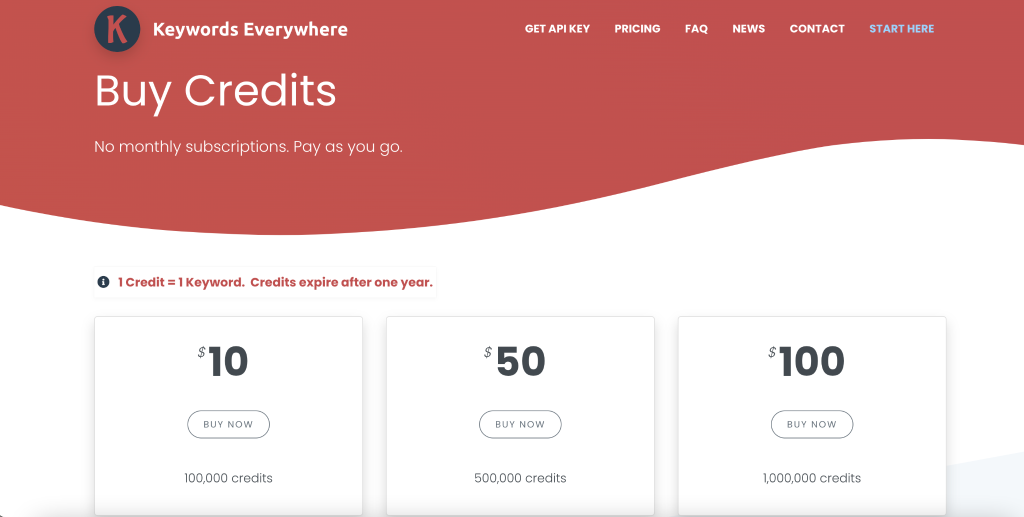
Final verdict for Keywords Everywhere
Score: 10/10
Standout feature: Showing keyword information on SERP. Overall, its great value for price and quality.
Semrush
Semrush is the most comprehensive SEO tool in the market. They’re in the small circle of SaaS SEO companies that offer many features to take an SEO project from conception to completion. While Semrush is excellent for SEO, link building, and social media, most of the content writing suite isn’t on par with competitors like MarketMuse, Frase, and NeuralText.
I’m going to focus on four features that can help you write and optimize content.
Keyword Magic Tool
Semrush Keyword Magic Tool is my go-to resource when conducting keyword research for large projects. I can find missing keywords, opportunities, gaps, and a ton of other keywords to explore.
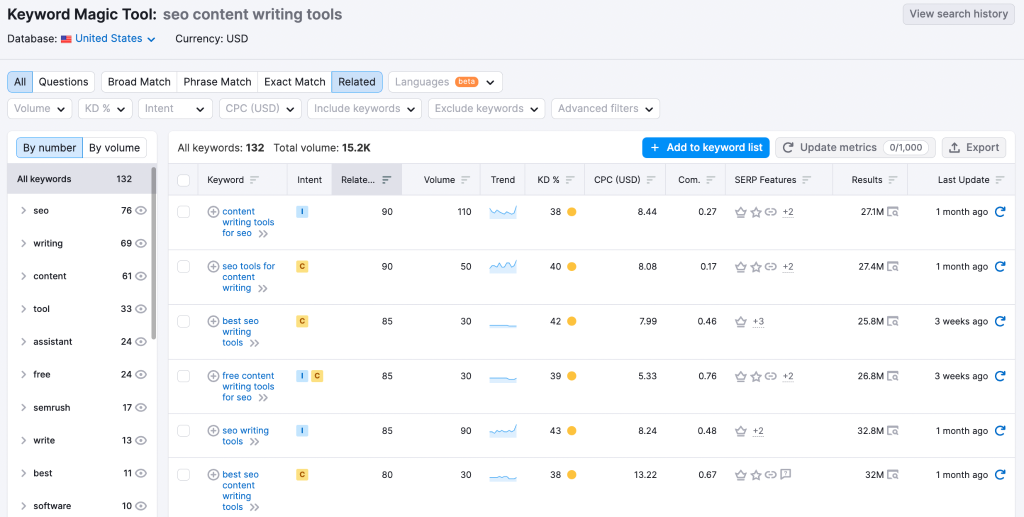
When writing content for one topic, I use Semrush to find secondary keywords and related topics to optimize the content. Stand-out features of the Keyword Magic Tool include:
- Search intent for the keyword and
- SERP features to improve on-page optimization
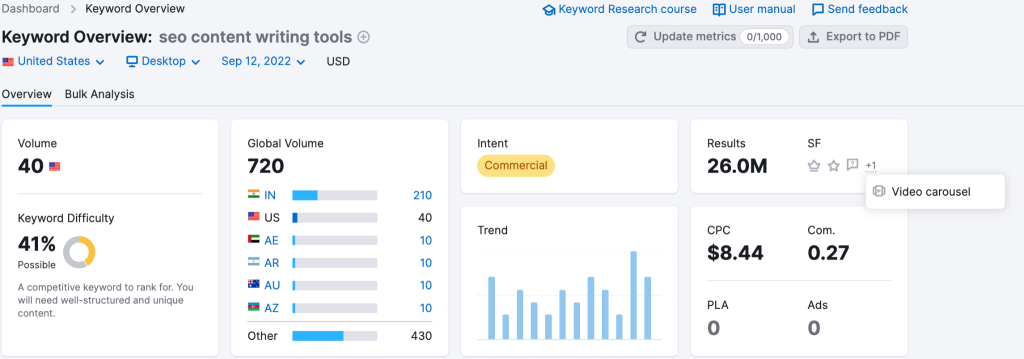
For example, I can see that SERP features for the keyword I’m targeting includes featured snippet, reviews, People Also Ask, and a video carousel.
Topic Research
If you already have a Semrush subscription and don’t want to spend money on a content brief tool, use the Topic Research section to explore topics related to the keyword and gain insight on how competitors use the word when writing.
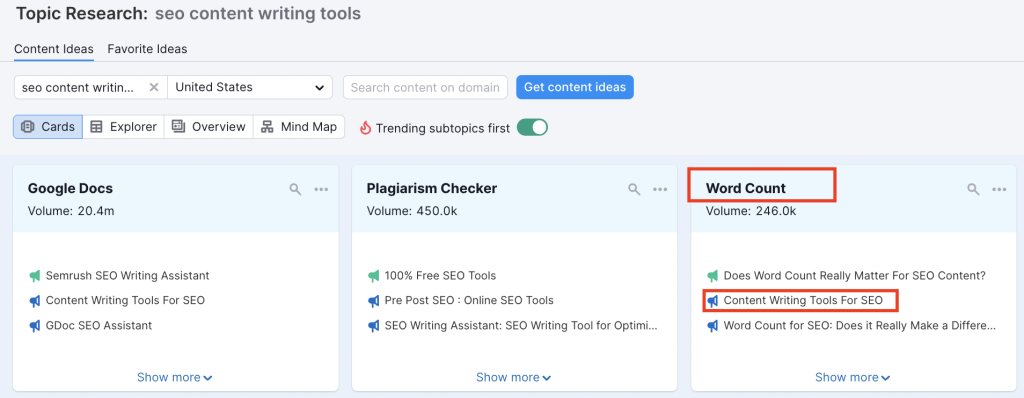
For example, word count is a related phrase that comes up repeatedly. I’ll click on show more and open any of the relevant results that mention content tools to see how they used the topic.
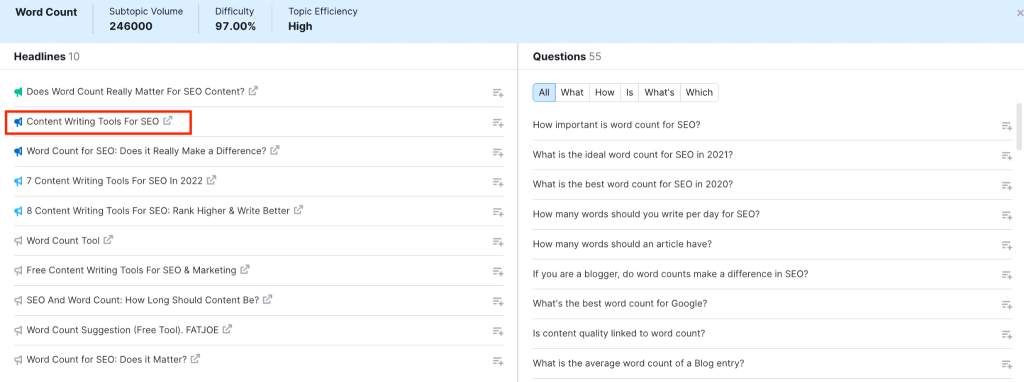
The information on the right helps you structure the subheading and answer questions related to the topic and primary keyword.
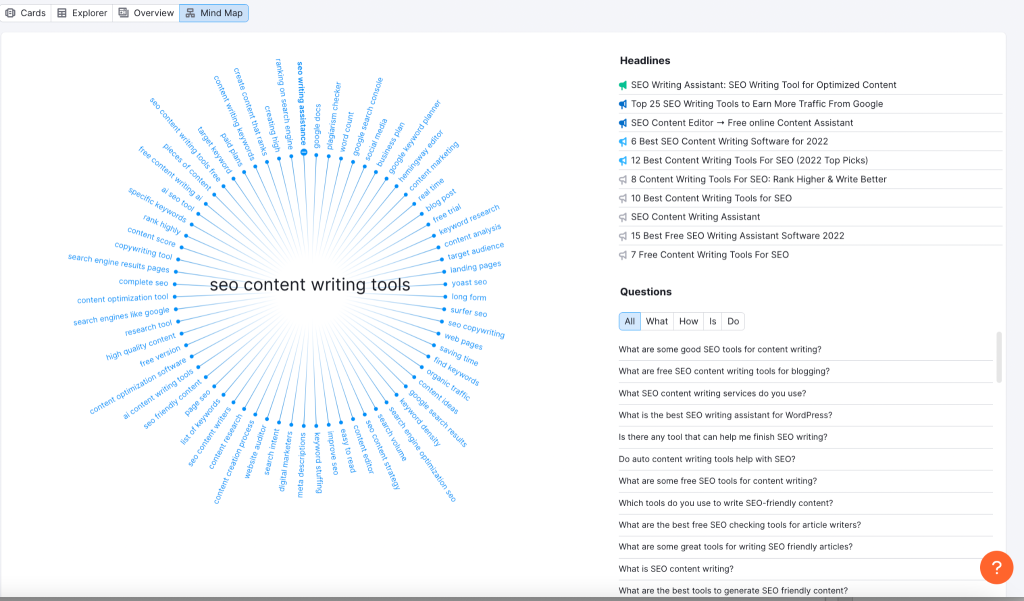
If you’re a visual person, head over to the Mind Map to view:
- Secondary keywords
- Relevant topics
- Headlines
- Questions
- Related searches
Personally, I’ve seen decent results when using the questions as H2 or H3 subheadings.
SEO Content Template and SEO Writing Assistant
Like I said in the video review, the Content Template and SEO Writing Assistant are barebones when compared to content brief tools like NeuralText and MarketMuse. The list of semantic words should be longer with the frequency of use attached. The rest of the SEO recommendation isn’t useful because I already know the ideal length of a meta description and page title.
However, there are some data you can pull from the content template such as:
An overview of the top 10 competitors ranking for the keyword
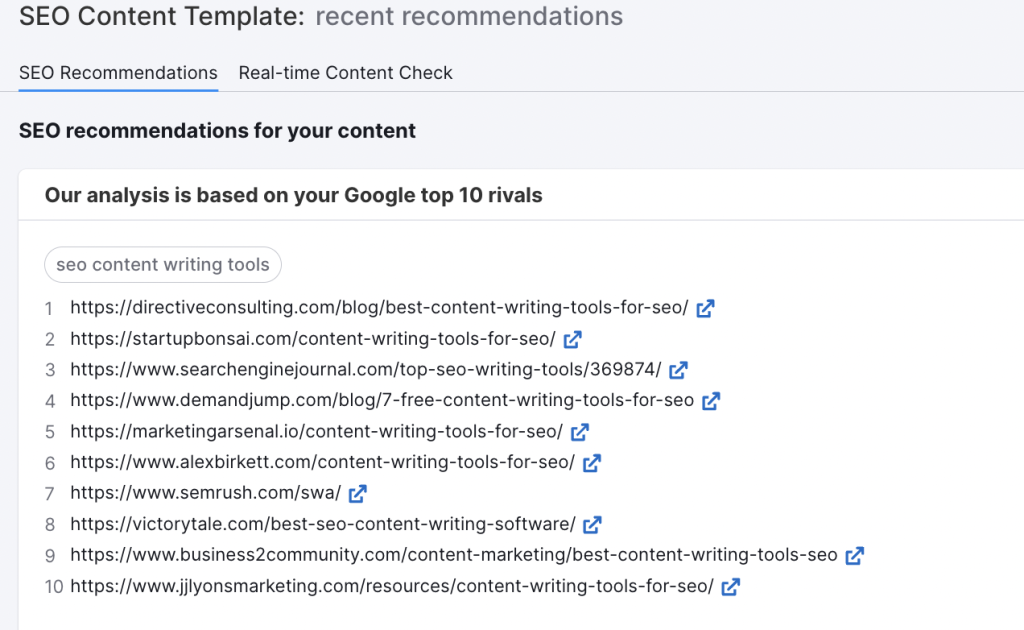
Ideal word count, readability score, and semantically related words

If you click on Real-time Content Check, it takes you to the SEO Writing Assistant where you can optimize your content with features like:
Readability
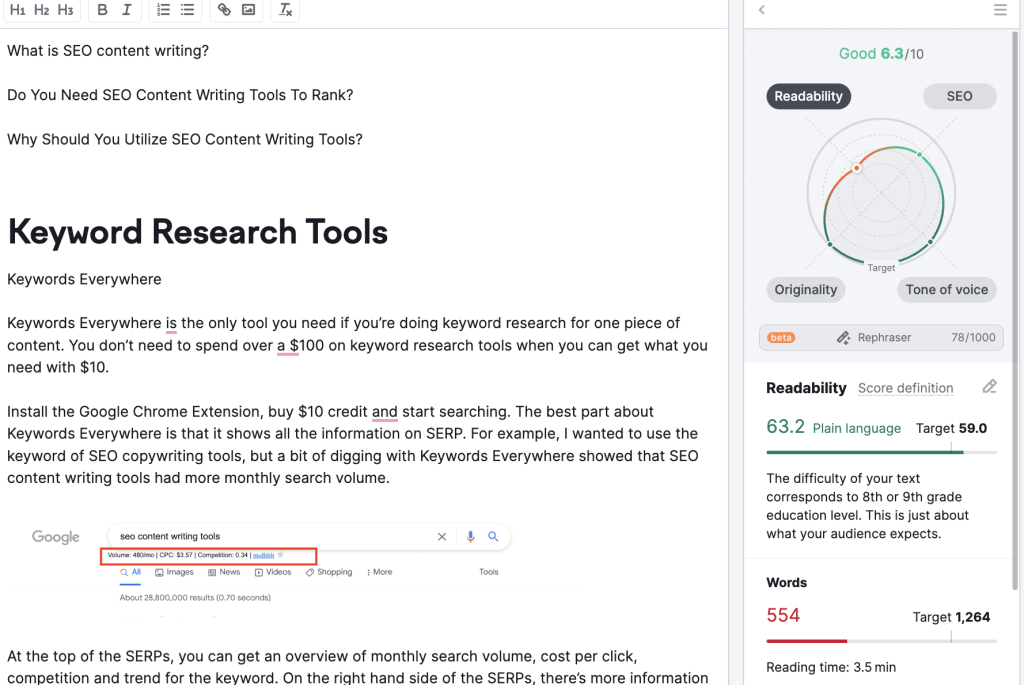
Use of recommended semantic words
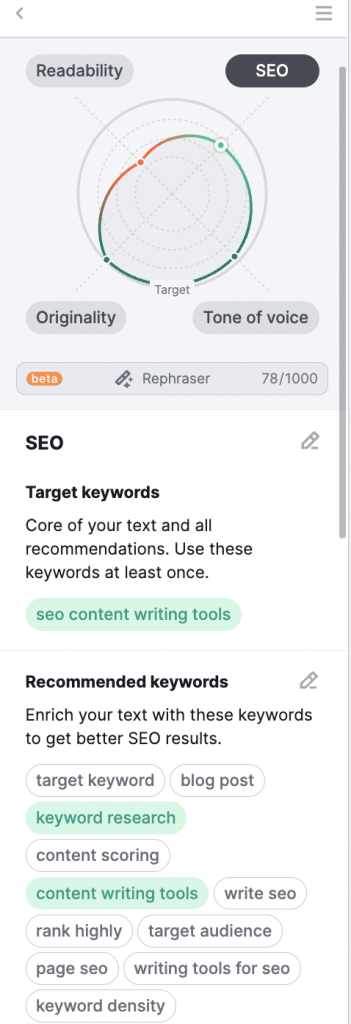
Rephraser
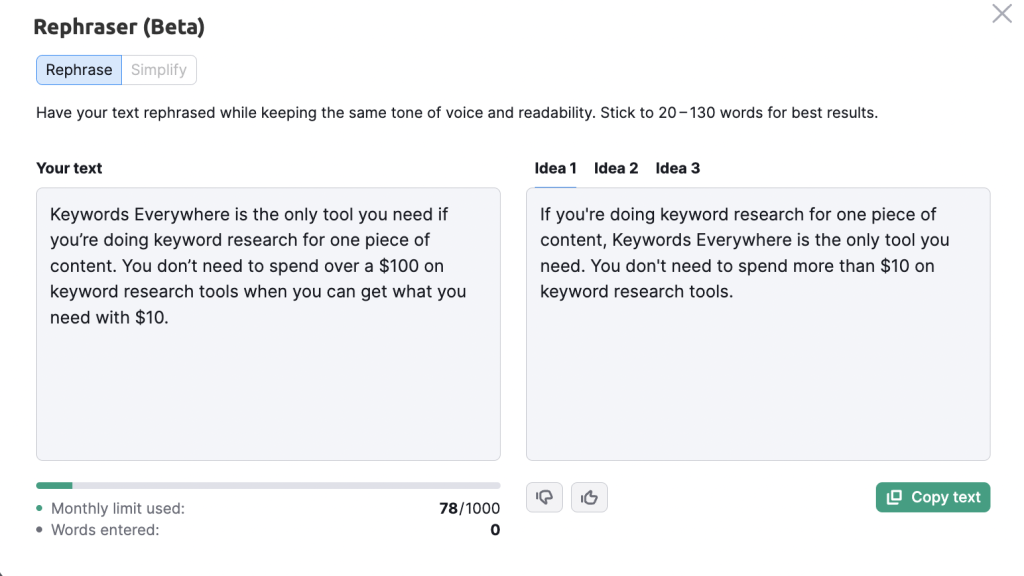
Semrush pricing
There are three pricing models on Semrush, and they include Pro, Guru, and Business:
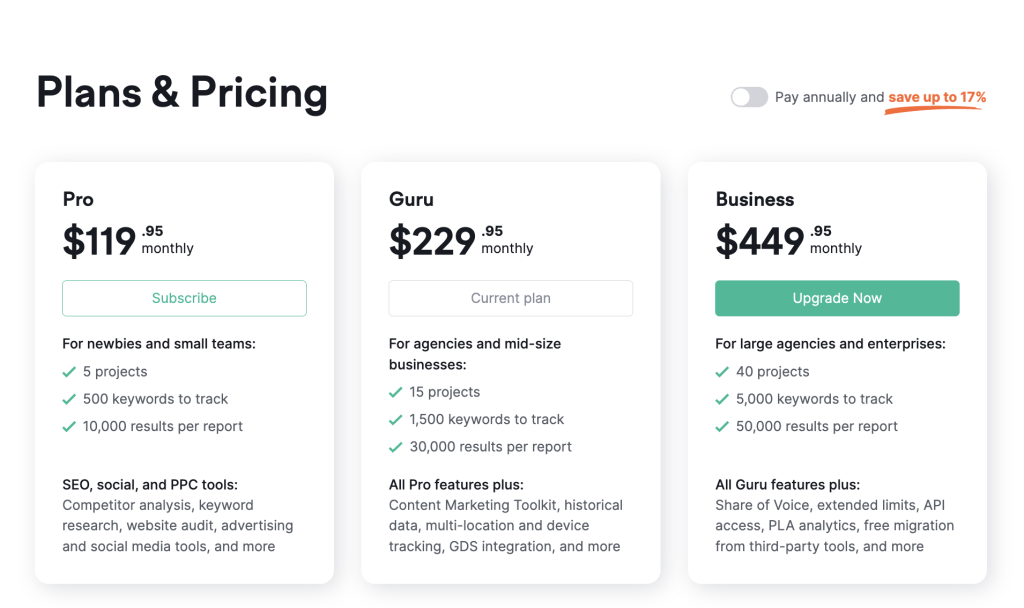
I would recommend the Guru plan as it includes the Content Marketing Toolkit that’s not available on the Pro plan.
Final verdict for Semrush
Score: 7/10
Standout feature: Topic Research and Keyword Magic Tool
If I was only reviewing the keyword research feature, I would have given Semrush a perfect score of 10. However, they have a content marketing toolkit that falls short of expectation which impacted the total score.
Ahrefs
Ahrefs was the first tool that made sense to me when I started learning about SEO copywriting. The interface was easy to use, features were limited, and I didn’t feel overwhelmed by options. Since this article is focused on content writing, I’ll only talk about Ahrefs features that help you conduct keyword research, find entities to optimize content and track results after publishing.
Ahrefs Keyword Optimizer
Head over to the Keywords Explorer section and type in your keyword. Google is the default search engine, and the United States is the default location. Matching terms show variations of the keyword or topic, and you can filter results by questions, phrase match, word count, and more.
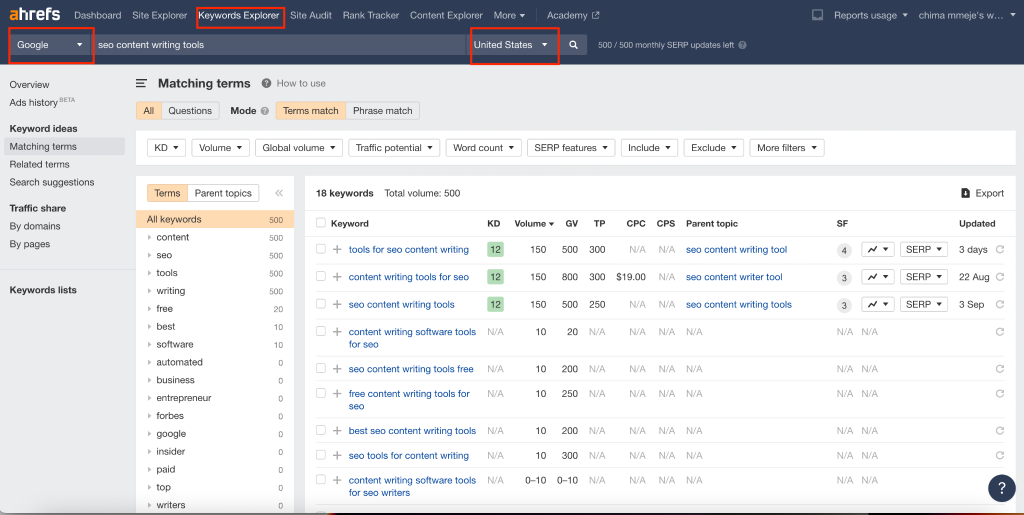
If you don’t have the budget for a content brief tool, but need to extract semantic entities, navigate to Related terms, and filter results by Also talked about. For example, from the data below, to rank for SEO content writing tools I should cover topics like Google Search Console and Google Docs. Next, highlight all the keywords and export as a Microsoft Excel file to access the list offline.
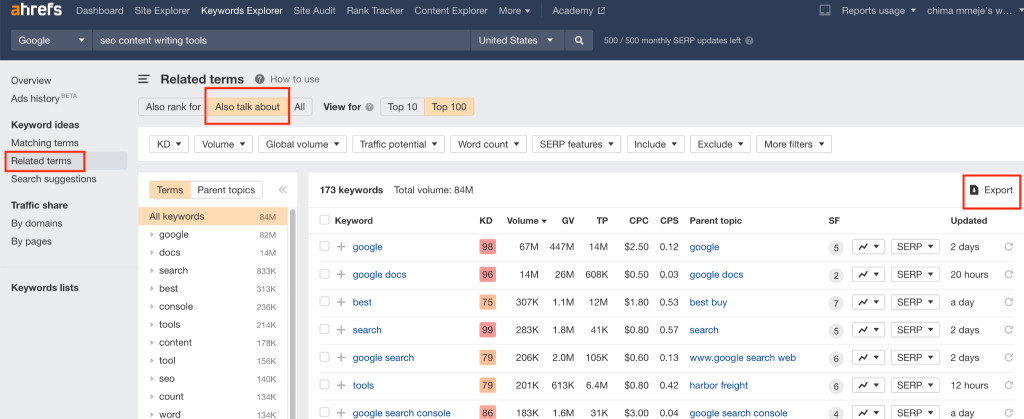
Content Explorer
If you want to do a bit of competitor research before writing, Ahrefs Content Explorer can help. You’ll see information about the top authors for the keyword, word count, social shares, traffic, and more on-page information.
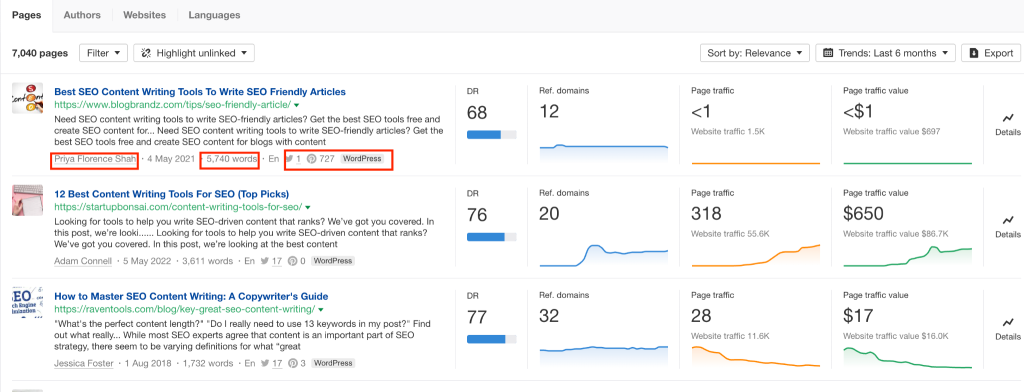
Ahrefs pricing
There are four pricing models on Ahrefs, and they include Lite, Standard, Advanced and Enterprise.
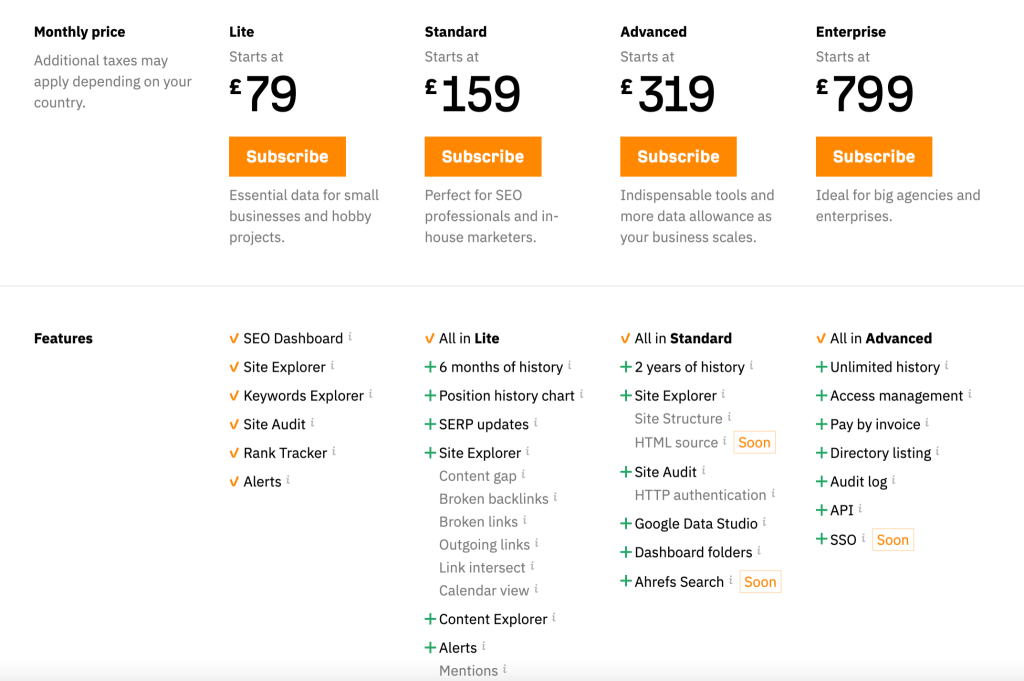
The Standard plan is the best option if you work solo, the advanced plan is great for teams and the Enterprise is ideal if you need API integration.
Final verdict for Ahrefs
Score: 7/10
Standout feature: Ahrefs Keyword Optimizer
I would like to see more data on the Content Explorer such as how competitors use topics, the frequency of use and some sort of information on important topics to cover when discussing the keyword. Author information and domain rank doesn’t help writers create content briefs or optimize content.
AlsoAsked
I’m an evangelist of not writing for SEO or obsessing over how many keywords you can include on your page. Instead, I advocate for writing content that completely satisfies the user’s intent to the extent that they don’t go back to the SERP to read another content.
AlsoAsked achieve this mission by showing questions your audience is asking and anticipating questions they haven’t asked yet. It’s also a great resource for finding long-tail keywords, related keywords, and question-based keywords.
There are two ways to use AlsoAsked – you can conduct a standard search depth or a deep search. The difference between both options is that the deep search returns more questions than the standard search.
For example, here’s a standard search for SEO content writing tools:
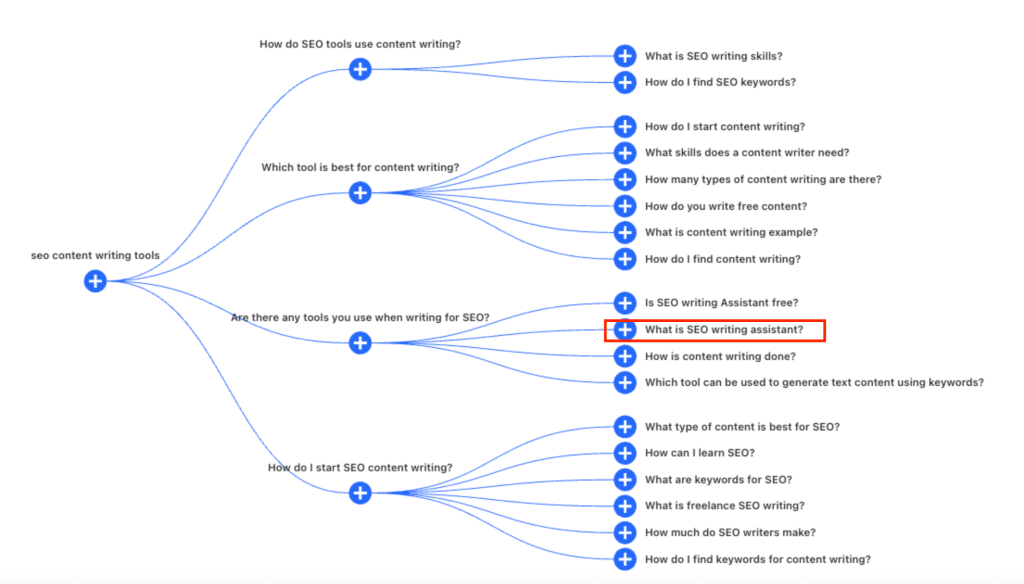
You have the keyword, and two levels of questions in the standard search result. Meanwhile, the deep search returns three levels of questions by digging deeper into the second level from the standard search.
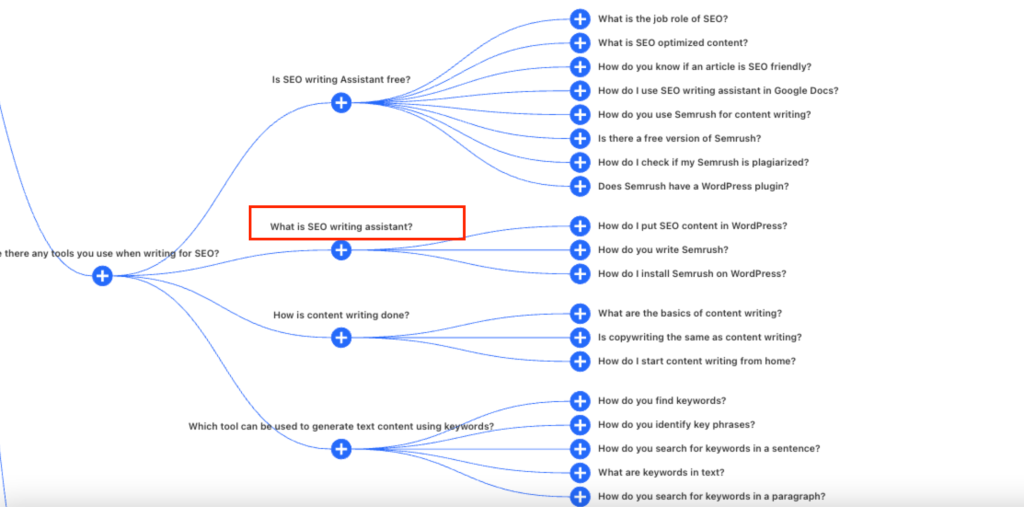
This depth will be useful if you’re writing pillar pages and need to flesh out a topic thoroughly. It’s also great for finding FAQ questions to answer when writing long-form content. You can compare the answers from AlsoAsked with the Mind Map from Semrush Topic Research to understand which tool is better for finding People Also Ask queries.
AlsoAsked pricing
There are three pricing models on AlsoAsked, and they include Basic, Lite and Pro plans.
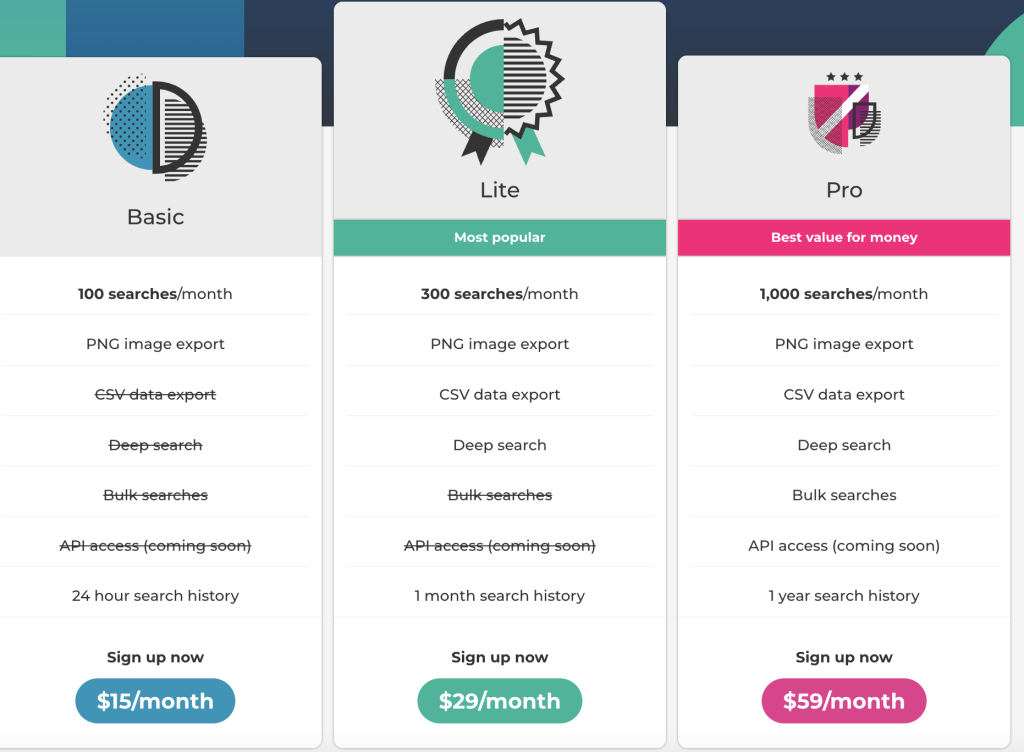
Pricing for AlsoAsked starts at $15 per month for the basic plan and includes 100 monthly searches. I recommend getting the Lite plan if you want the deep search feature with CSV data export at $29 per month.
Final verdict on AlsoAsked
Score: 10/10
Standout feature: Deep search
AlsoAsked does what it’s supposed to do, and I have no complaints or suggestions. I especially appreciate the deep search feature that sets it apart from competitors like Answerthepublic.
Honorable mentions for keyword research tools
- Google Search Console: The true source of keyword search volume
- Answer the Public: Great for finding long-tail keywords, related questions and people also ask queries
- Google Keyword Planner: Free resource to find long-tail keywords for a topic
- Google Trends: Best resource for researching seasonal keywords
- Question DB: Large database to find question-based keywords
Content Optimization Tools
Frase
Frase is a content marketing tool that helps you create content briefs and optimize written content. It’s affordable, automates workflows and ensures you’re using enough topics when writing.
There are three Frase features to focus on:
Content Brief Template
Import a custom content brief template or use one of Frase’s templates to generate a brief. Features you can add to your content brief include:
- Word count
- People also ask
- Statistics
- Top ranking SERP
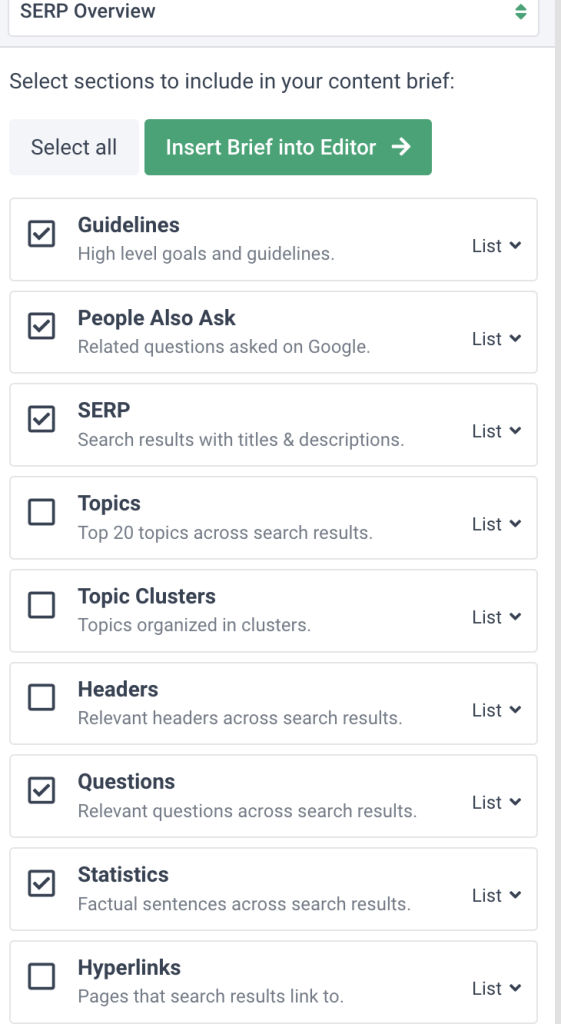
If you’re a visual person, click Outline on the right side of your screen and Frase shows you the subheadings across the top-ranking pages in a horizontal format.
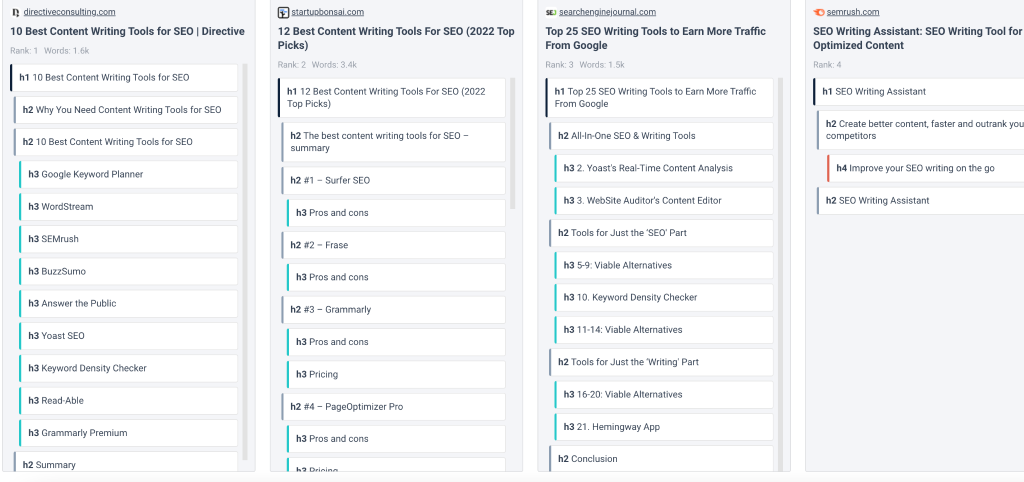
The visualization is a quick way to identify recurring subheadings across the top-ranked content. For example, I can tell from the screenshot above that Grammarly and Yoast SEO are important topics for the keyword I’m targeting.
AI Write
I’m not a fan of AI writing tools because I think they regurgitate emotionless words that lack empathy and cannot connect with humans on a deeper level. Words should make you feel, think or act.
However, AI writing tools can help with automating writing tasks such as meta descriptions and headlines. Also, it serves as inspiration when you’re feeling stuck and need a creative jumpstart.
Features of Frase AI Write include:
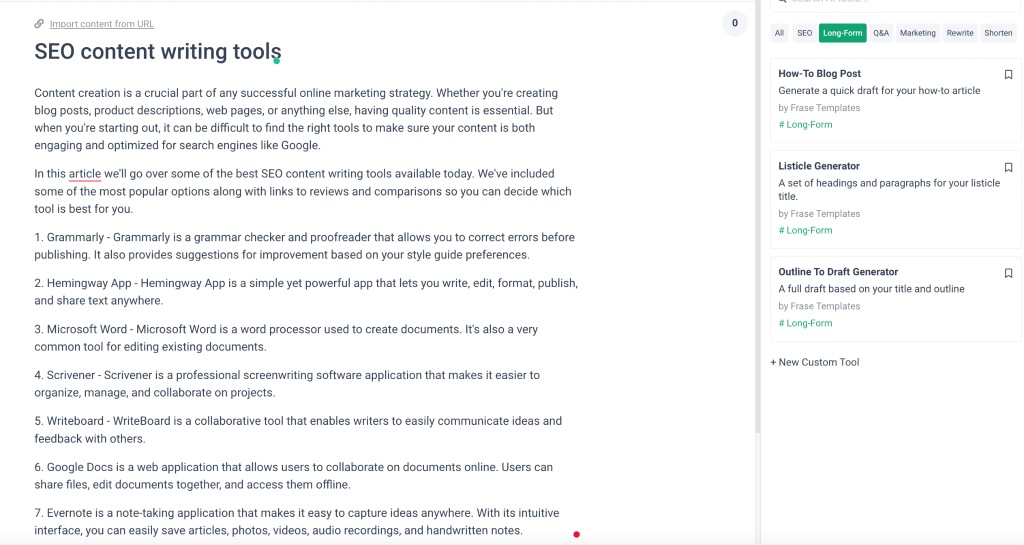
Build a full draft based on a custom outline:
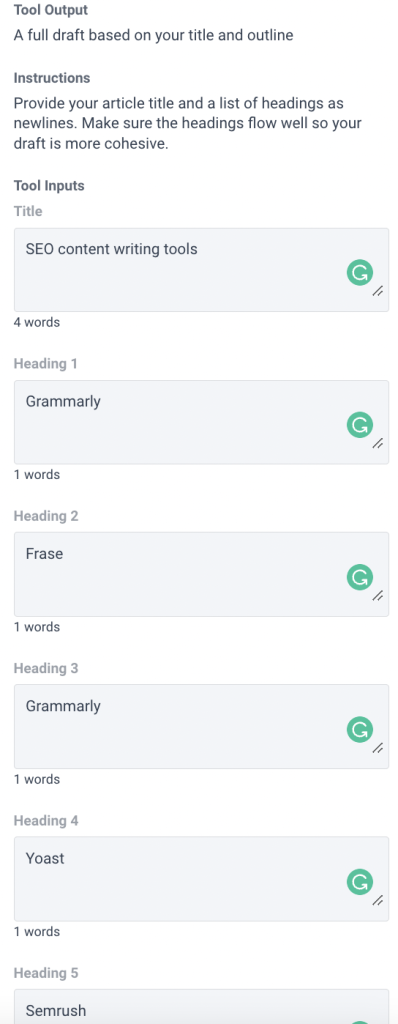
I add the title of the blog post and as many subheadings as I want to cover in the tool inputs. Frase AI writes the content and I copy the text to the editor.
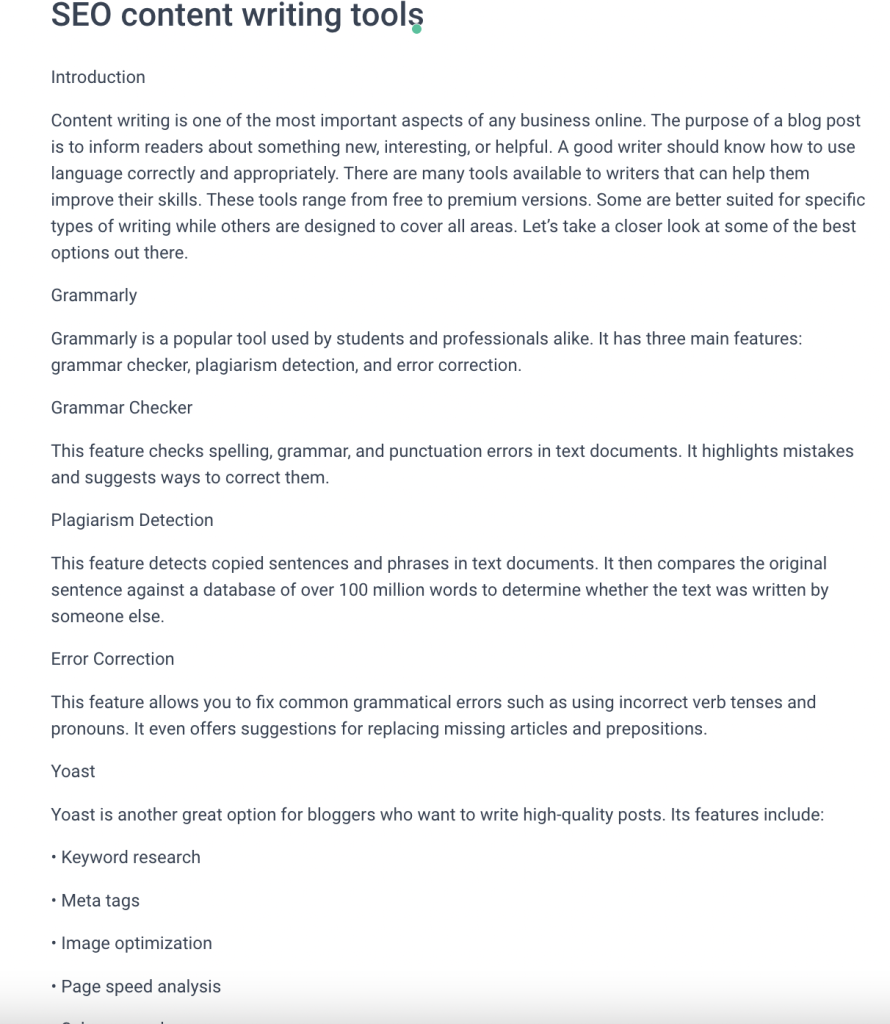
This is good text on a basic level and it’s difficult to tell that it’s AI-generated content. Please take a few hours to play around with the AI Write, because there’s so much you can do with it.
Optimize
After writing, paste the content in Frase and you’ll get a score showing how well you’ve used semantic entities in the content.
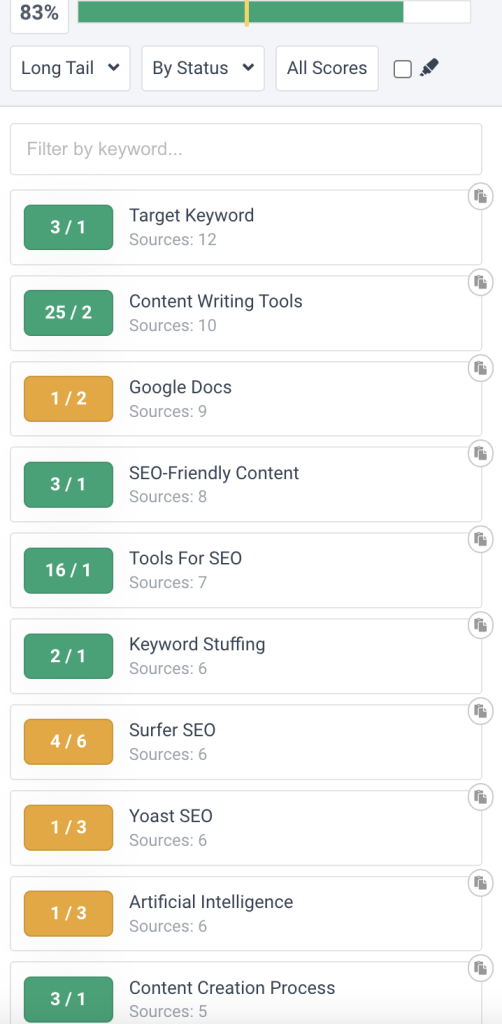
Additionally, it’s an opportunity to include more topics you might have missed while writing. Remember, the goal is to use topics and semantic words naturally, not force them arbitrarily in the text.
Frase pricing
There are three pricing models on Frase, and they include Solo, Basic and Team plans.
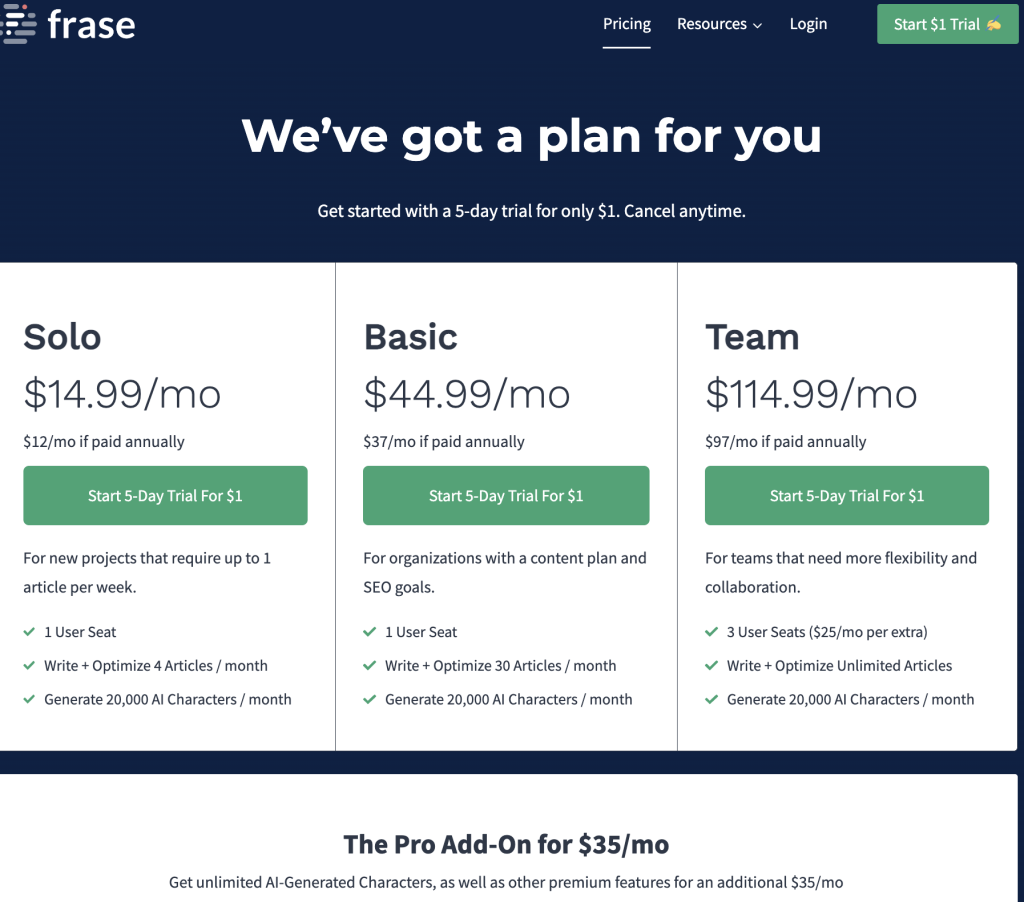
I use the Basic plan because it offers 30 content briefs. If you want keyword research, unlimited access to AI Writer and more SERP data, it cost an additional $35 for the Pro Add-On.
Final verdict on Frase
Score: 8/10
Standout feature: AI Writer and Content Briefs
It would be nice to have the keyword research feature as part of the Basic or Team plans even if it cost a bit more. I’ve used Frase to build content briefs and optimize projects for the past year and it’s been back-to-back hits.
NeuralText
I bought NeuralText in 2021 as an investment that would pay off in two to three years. One year later and NeuralText is now a worthy competitor. If you’re looking for a content marketing tool that does keyword research, content briefs, content optimization, and AI writing, NeuralText is all you need.
There are three NeuralText features to include in your content workflow.
Keywords Ideas
The Keywords Ideas tool is great for researching viable keywords. It includes trends data over a one-year period, search volume, and keyword difficulty.
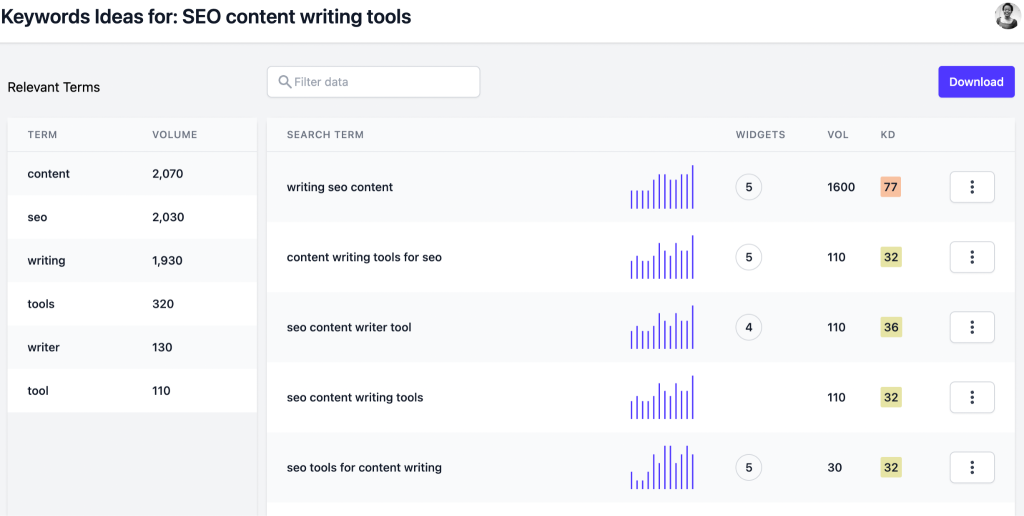
If you’re building topic clusters for a larger project, import your keyword research data into NeuralText and flesh out clusters for the keywords.
Content Briefs
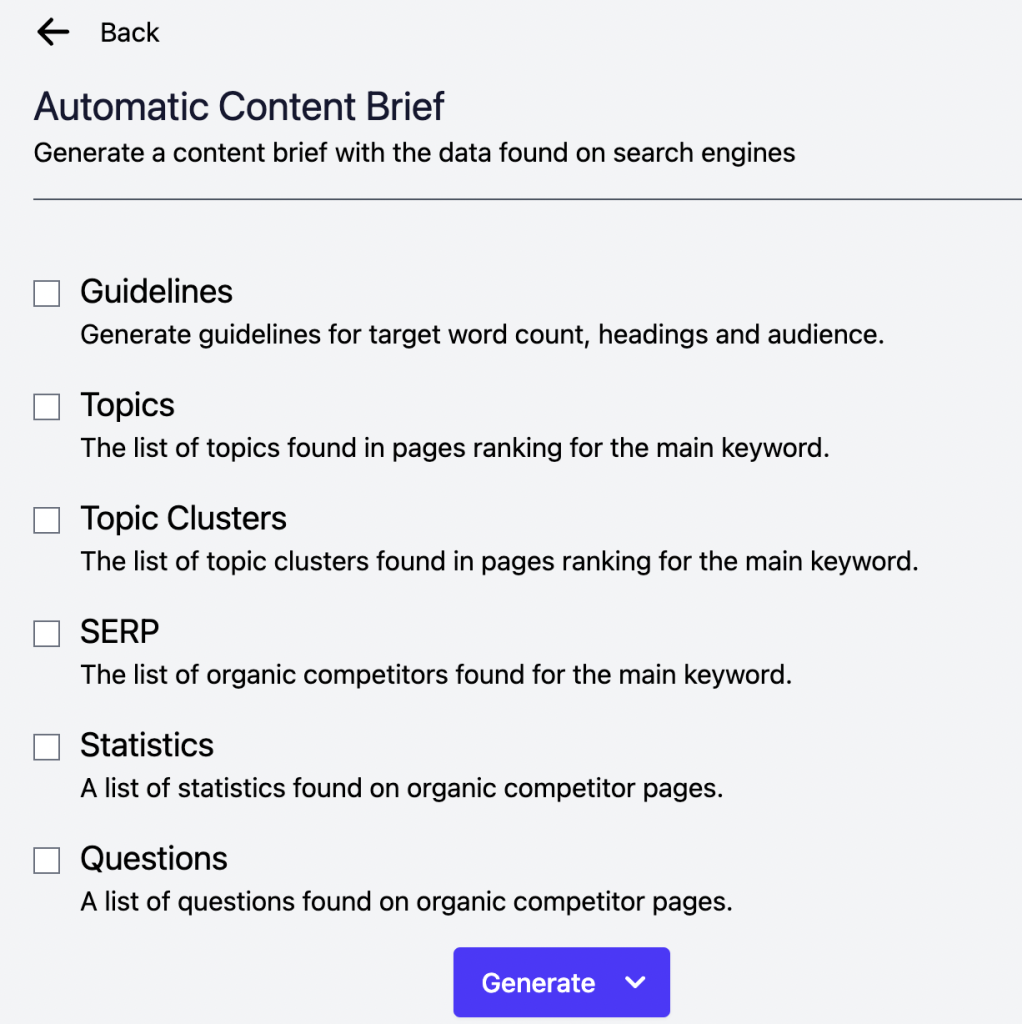
I noticed many similarities between NeuralText and Frase’s content briefs including features like topic clusters, word count, statistics, SERP, and questions. However, the data is impressive and useful enough to create a detailed content brief.
To get an overview of content outlines across the top-ranking SERP, click on See SERP Analysis and select Outline.
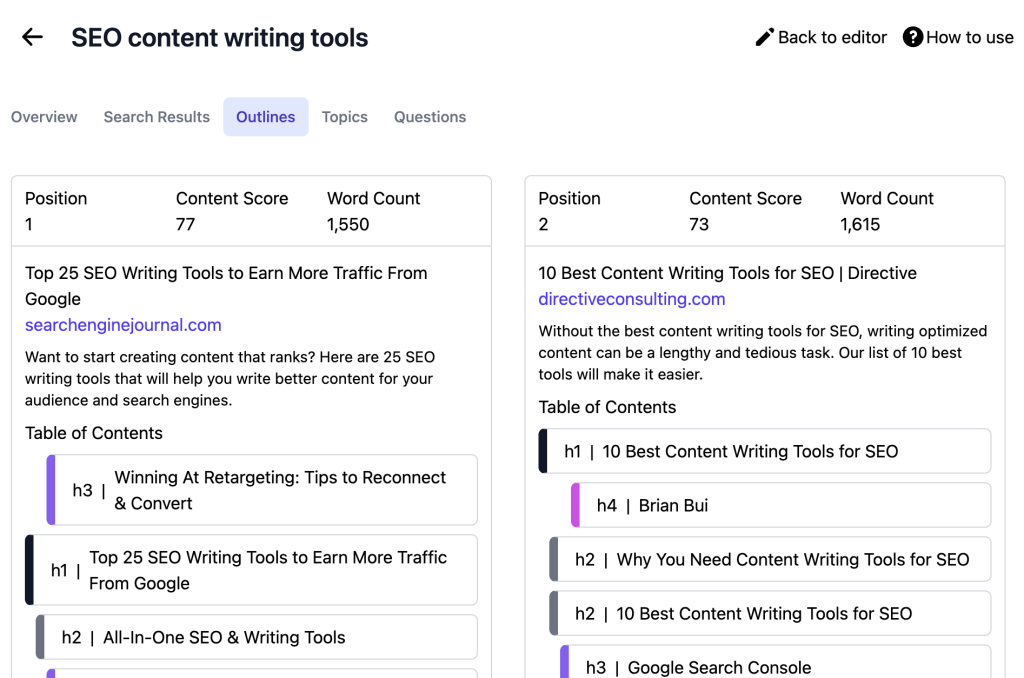
NeuralText shows you the:
- Content score
- SERP position
- Word count
- Meta description and
- Outline for each page ranking for the targeted keyword
AI Writing Templates
There are 40+ AI writing templates on NeuralText to help you automate content.
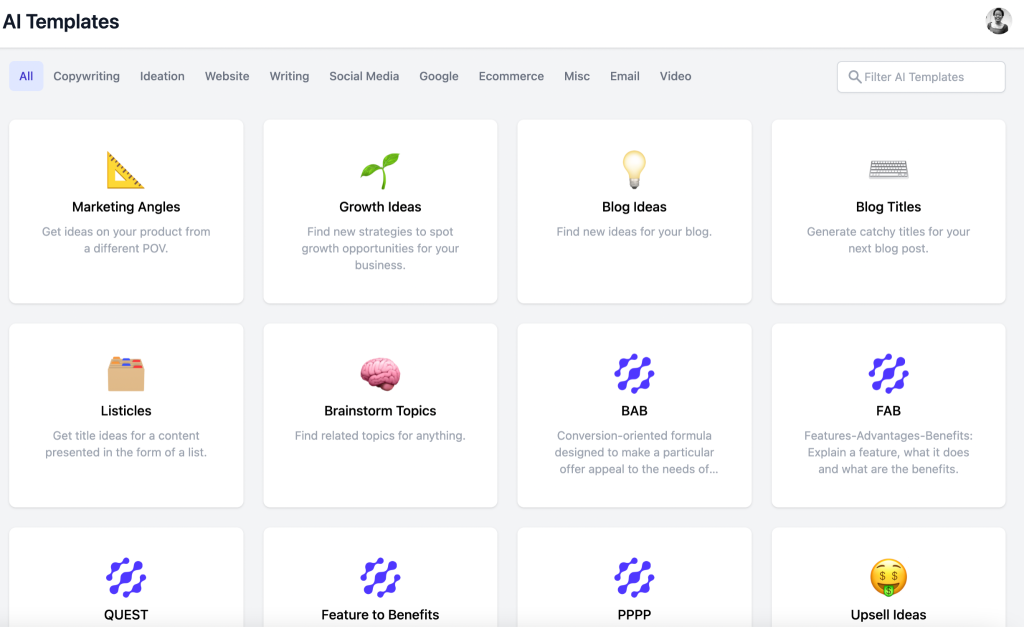
I played around with the Blog Outline and Blog Intro templates, and I prefer Frase AI Writing to NeuralText. The Blog Outline AI generates multiple outlines (seven for this piece) which makes it impossible to trust the information.
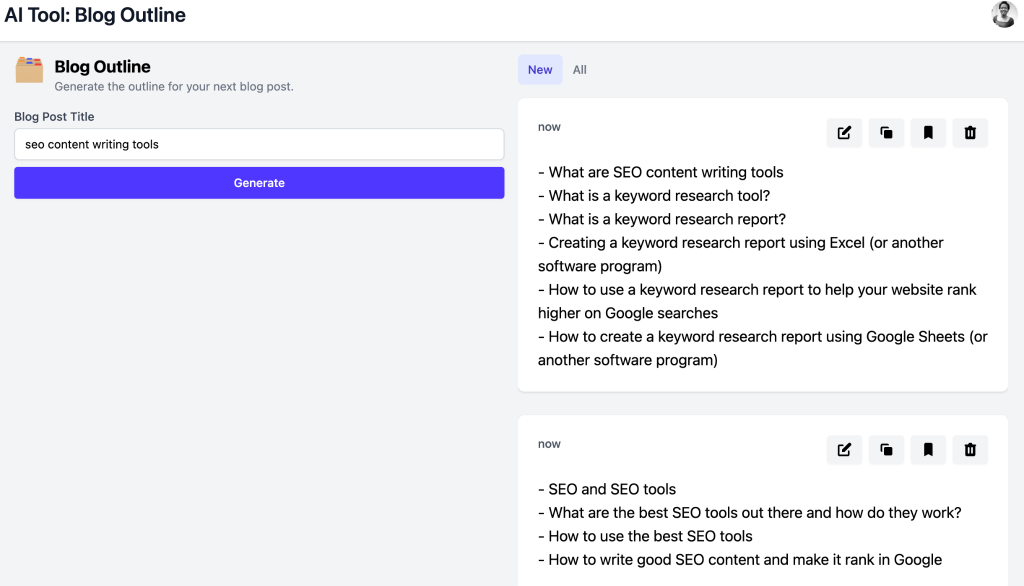
There’s no flow with the Blog intro and it’s easy to tell that it’s machine-generated text because of how awkward it sounds.

I would rather NeuralText cut some of the AI writing features and focus on making a few better. Again, this is useful for bulk text such as product descriptions and to jumpstart creativity when you feel stuck.
NeuralText Pricing
There are three pricing models on NeuralText, and they include Starter, Basic and Pro plans. Is anyone else noticing the pattern of the first plan being a placeholder for the second plan which offers more value?
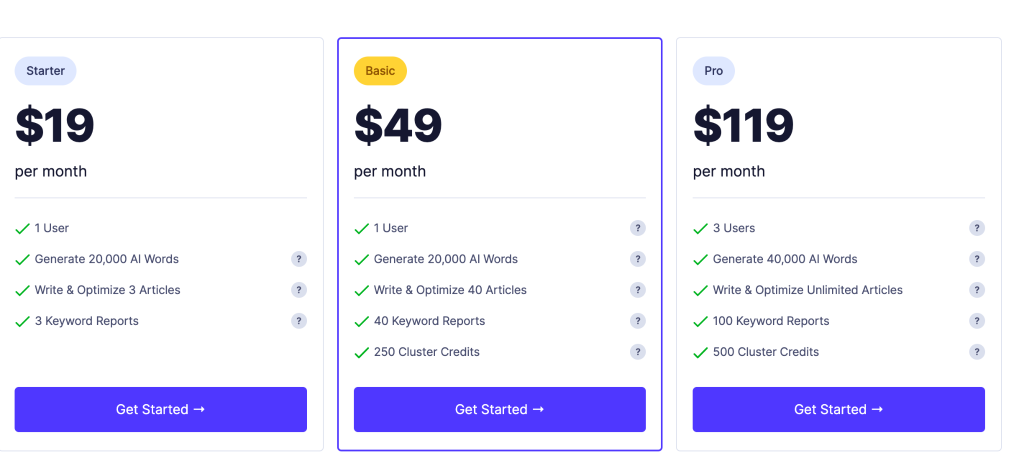
Final verdict on NeuralText
Score: 7/10
Standout feature: Keyword ideas and content briefs
Neural Text provides enough information to build a content brief and optimize written content. However, it’s a work in progress. The list of topic suggestions needs to match the quality of Frase, Clearscope and MarketMuse. Also, the quality of text and sentence structure in the AI Templates is not as good as Frase.
MarketMuse
I believe in the supremacy of MarketMuse as the best content optimization tool on earth. The first time I used MarketMuse was on a client project in 2020. The client was a pet review site that wanted to rank for highly competitive navigational keywords, and I thought they were crazy to even make an attempt.
However, I was shocked to discover that all three pages I wrote ranked for the target keywords using only MarketMuse to create the briefs and optimize content.
Here are a few ways to use MarketMuse in your workflow:
Research
The UI and dataset for the topic research on MarketMuse are similar to Clearscope’s Keyword Discovery. You can research a topic and get insight into related topics to cover as part of a cluster or subheadings in the content.
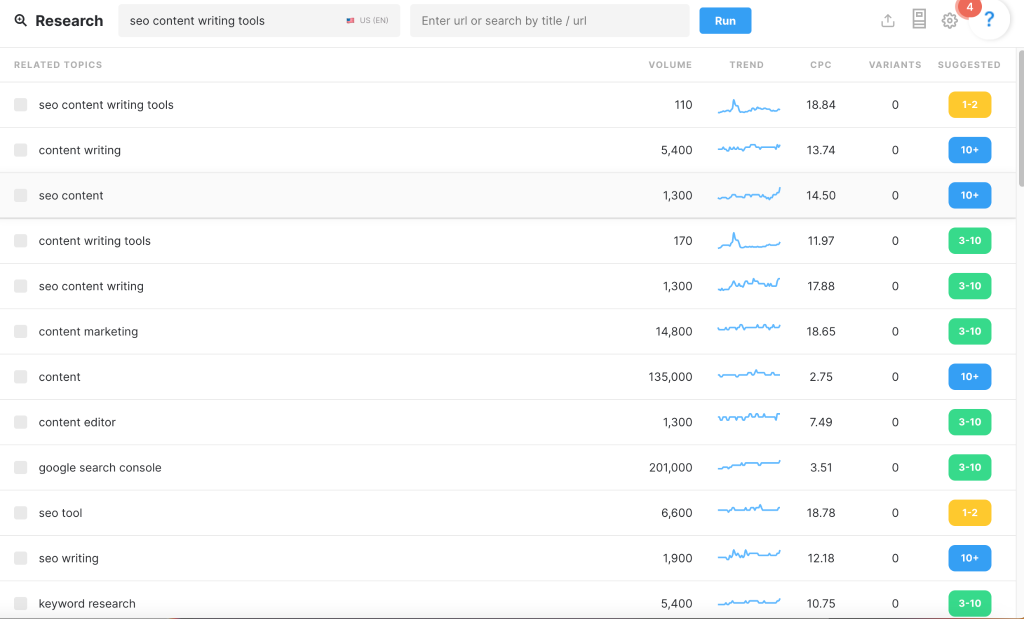
In the past, I’ve used MarketMuse Research when building a niche cluster with low volume keywords. It saved time doing competitor research and scrolling through pages of keyword data to find something relevant.
Compete
Want to see how your competitors implement topics in their content? MarketMuse uses a visual display to show you which topics to prioritize based on competitor usage.
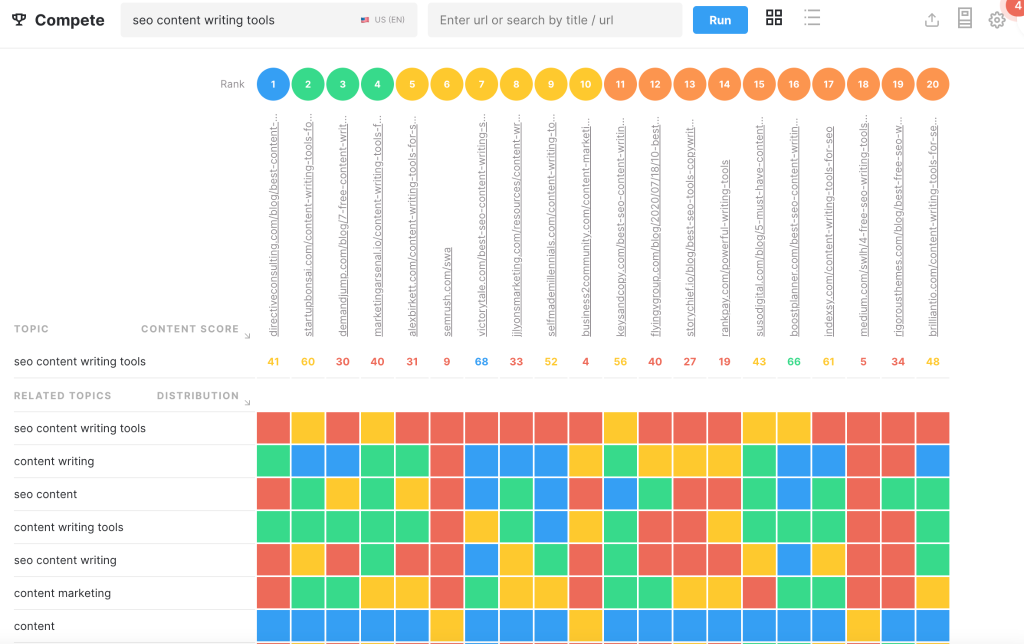
At the top you can see the top 20 pages ranking for the target keyword and just below the site names, you’ll see a content score.
The distribution is where it gets interesting:
Red – They didn’t use the topic
Yellow – They under-optimized for the topic
Green – They optimized sufficiently for the topic
Blue – They over-optimized for the topic
For example, looking at the data, I need to prioritize topics such as:
- Content writing tools
- Content marketing
- SEO content
Brief
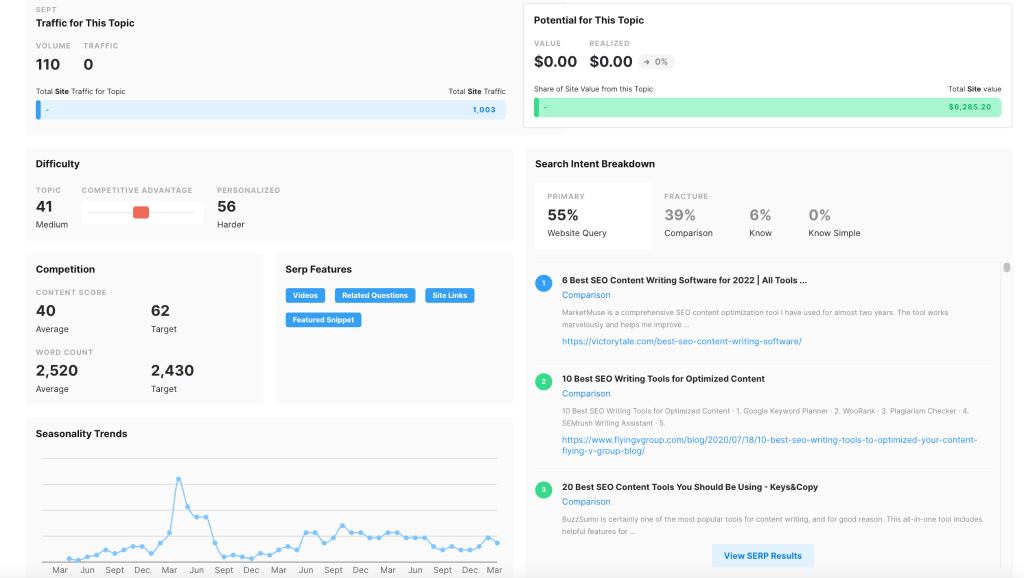
At a top-level glance, the brief shows primary statistics such as SERP features, monthly search volume, and search intent breakdown for the target keyword. I appreciate the search intent breakdown because there are certain keywords with multiple search intents and MarketMuse uses percentages to show all the keyword intent.
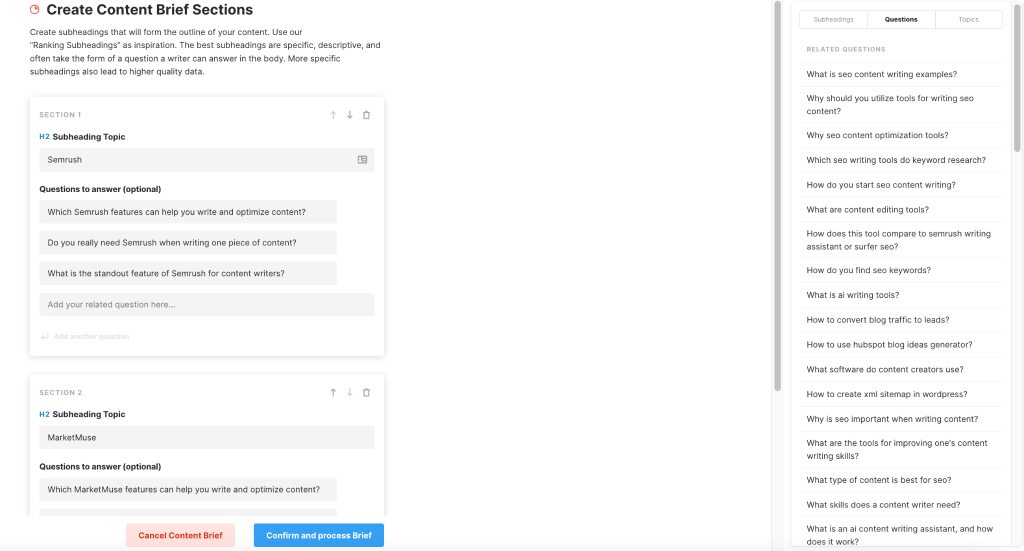
Related topics on the right-hand side are useful for finding subheading suggestions. If you’re creating briefs for freelance writers, it allows you to go deeper by adding more questions to answer in each subheading.
MarketMuse uses the data you’ve entered to create a report that includes:
- Word count
- Content score
- Suggested internal and external links
- Terms to include in your title and subheadings
- Topics to mention that help you build topical authority for the keyword
While the information is great, I noticed that MarketMuse doesn’t show outlines of competitor content, which can be useful to see recurring subheadings across SERP and understand essential topics to cover.
Optimize
Personally, I believe that MarketMuse provides the best list of entities for optimizing content. After writing, copy and paste the content into Saved Writing and MarketMuse displays a content score based on how well you’ve optimized for relevant topics.
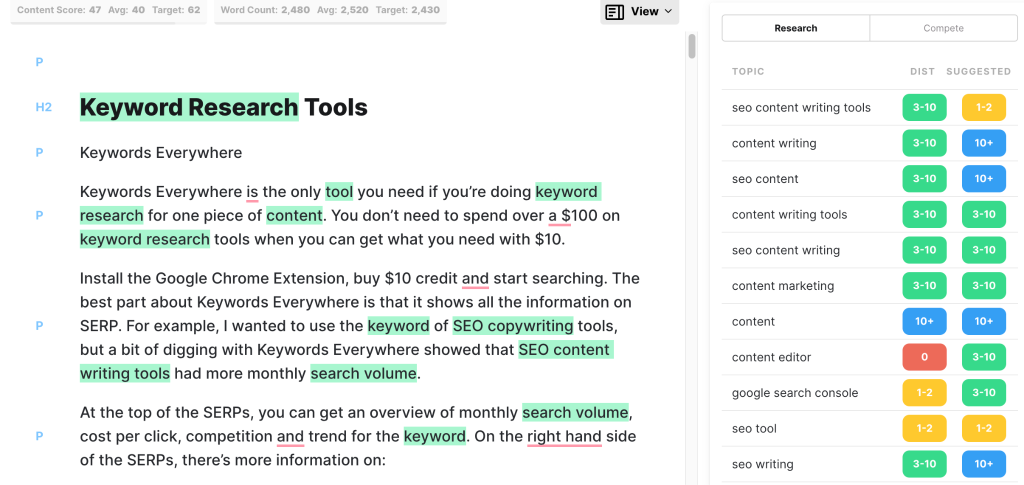
The topic information on the right-hand side shows if you’ve failed to optimize for certain topics or areas where you’ve over-optimized and need to use synonyms instead.
MarketMuse pricing
MarketMuse is the only tool I’ve reviewed that offers a free tier. You can conduct keyword research, create briefs, and optimize content on the free tier. Paid plans are charged annually and options include Standard and Premium.
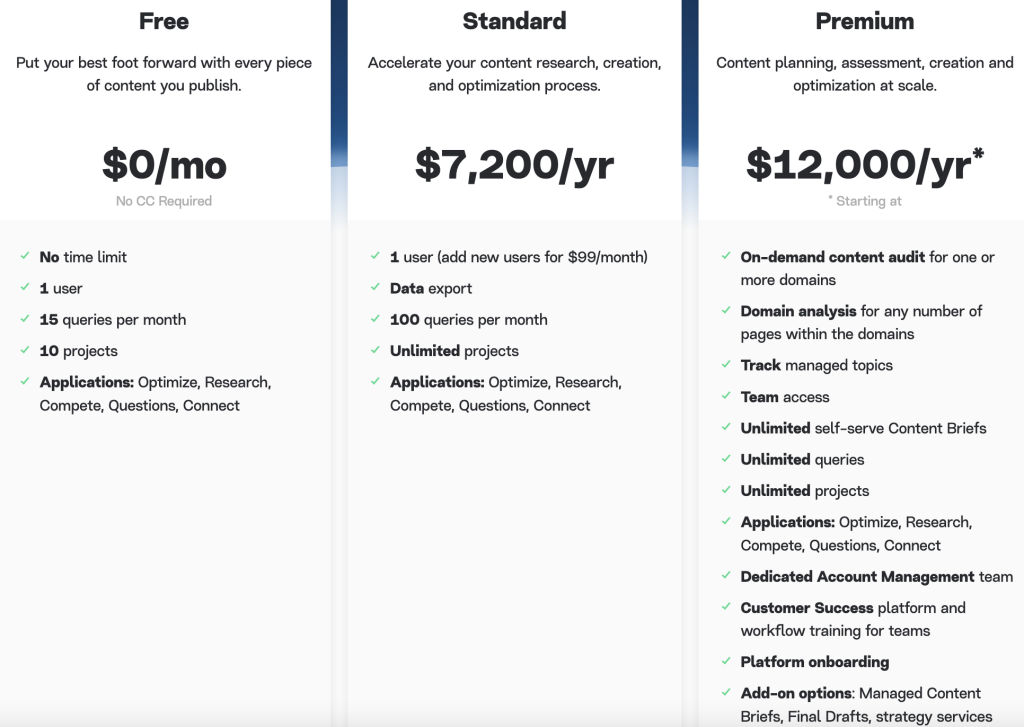
Final verdict on MarketMuse
Score: 10/10
Standout features: Compete and Brief
I love the free tier that gives you everything you need to manage small content projects. The brief guideline pushes you to look beyond what already exists to how you can answer each question comprehensively. Chef’s kiss to the developers and team working to make MarketMuse the best-in-class content optimization platform.
Clearscope
I spoke to Tory Lynne Gray, SEO Consultant and Founder of the Gray Dot Company about her experience with Clearscope, and here’s what she had to say:
“I’m a BIG fan of Clearscope because it cuts through the noise and gives me and the in-house content teams we work with, the right SEO data at the right time, without making me feel overwhelmed. In addition, Clearscope is great for on-page optimization support and keeping our projects organized which is a blessing.”
I’ll be honest – I’ve never used Clearscope before, but I was impressed with the simplicity of the UI which made it easy to sign up for an account and create a project in a few minutes.
I want to highlight three features of Clearscope for writing and optimizing content.
Keyword Discovery
The Keyword Discovery tool gives you the option to research keywords or URLs. Enter the URL of a top-ranking page to view secondary keywords they rank for and the level of difficulty.
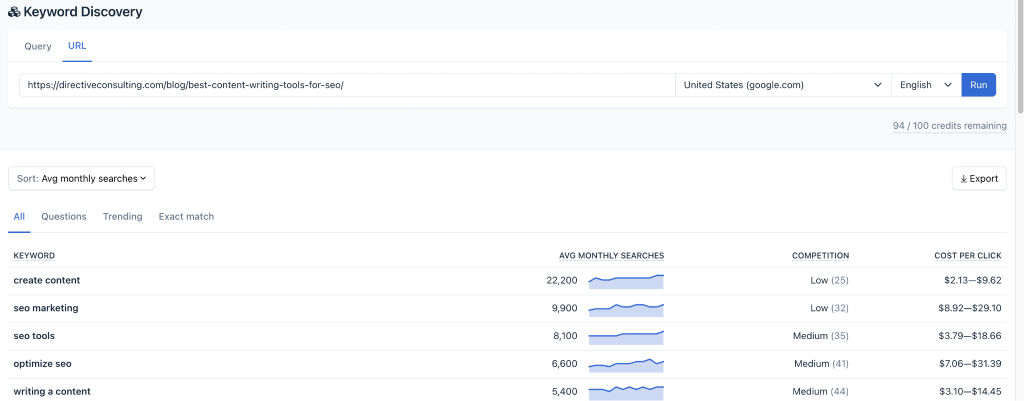
Alternatively, conduct traditional keyword research around the target keyword to find related terms, trending keywords, search volume, and competition.
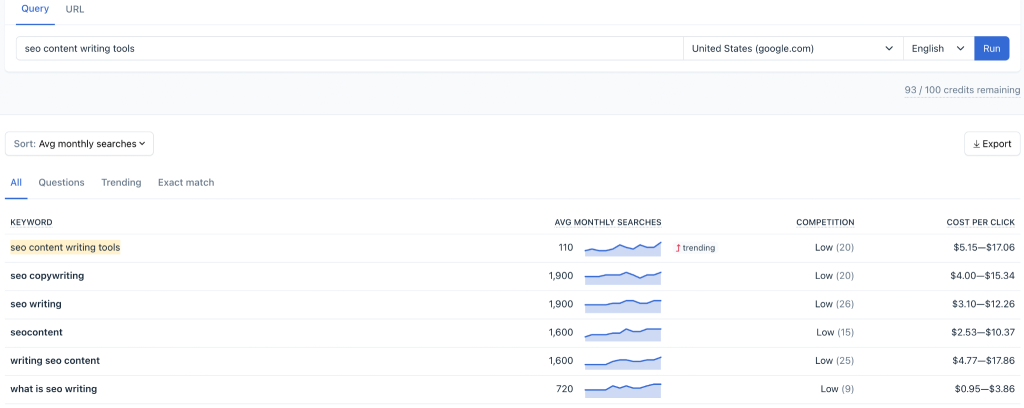
The data helps you:
- Nail down the primary keyword with the most search volume
- Understand the competition for the keyword
- Highlight trending topics to cluster for the target keyword
Report
Use the Report feature to build a manual content brief and optimize written content. I love that Clearscope is focused on content optimization and nothing else. However, it would be nice to have automated briefs that include outline, people also ask queries, and statistics referenced across SERP.
Terms
The standout feature of the Clearscope report is prioritizing semantic words and topics from most important to least important. For example, keyword research has a score of 10/10 which means it’s essential to use it 2-6 times when writing.
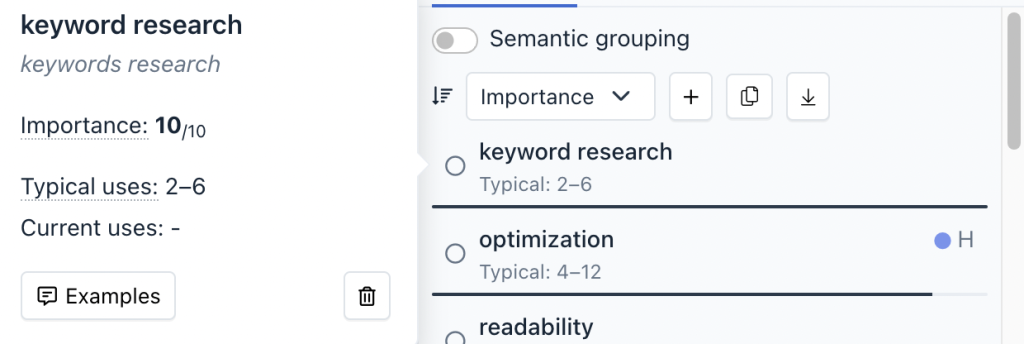
For context, click on Examples to see how competitors used the word in their content. Here’s how Directive and SEJ use the word “Keyword Research.”
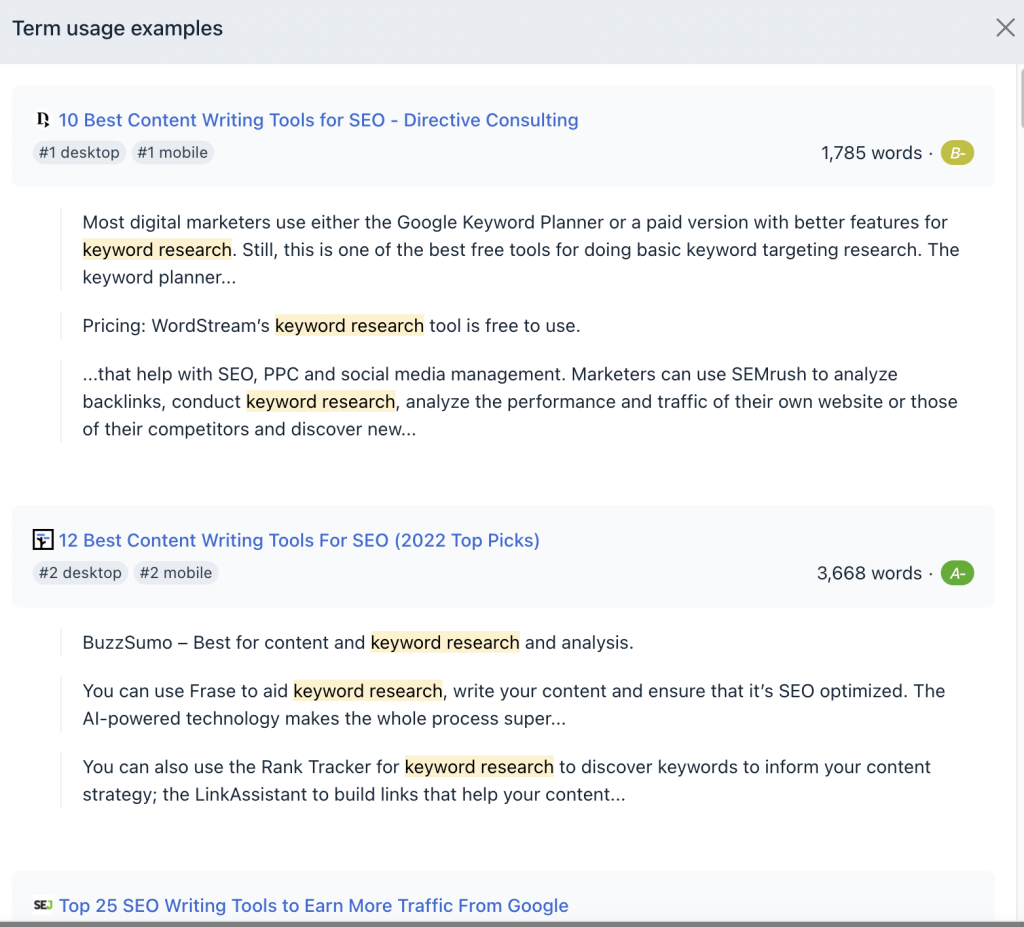
I inserted text from this content to see how the editor performed for optimizing written content.
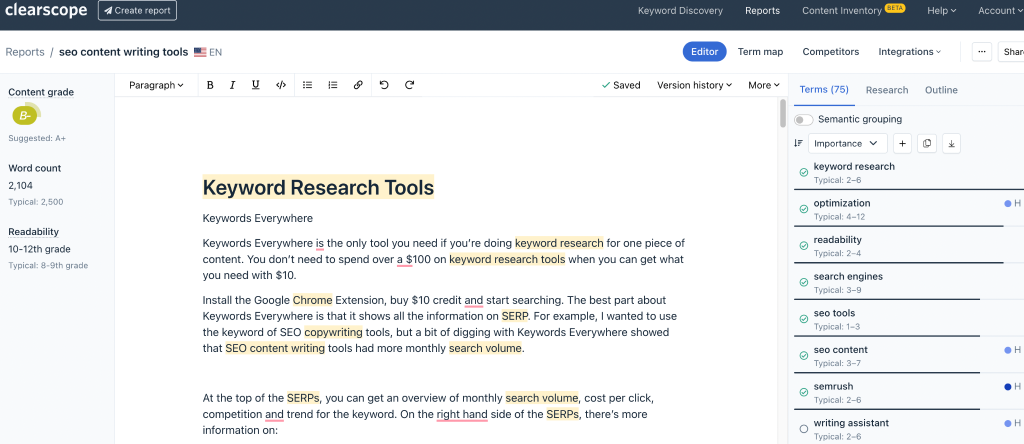
The left panel shows a content score, readability score and word count. Meanwhile, the right panel shows topics and frequency of use. The data helps you optimize the text by naturally inserting the semantic words without going overboard.
Research and Outline
The research feature shows you questions to answer when writing content for a target keyword. It also includes the most common topics referenced across SERP for the keyword.
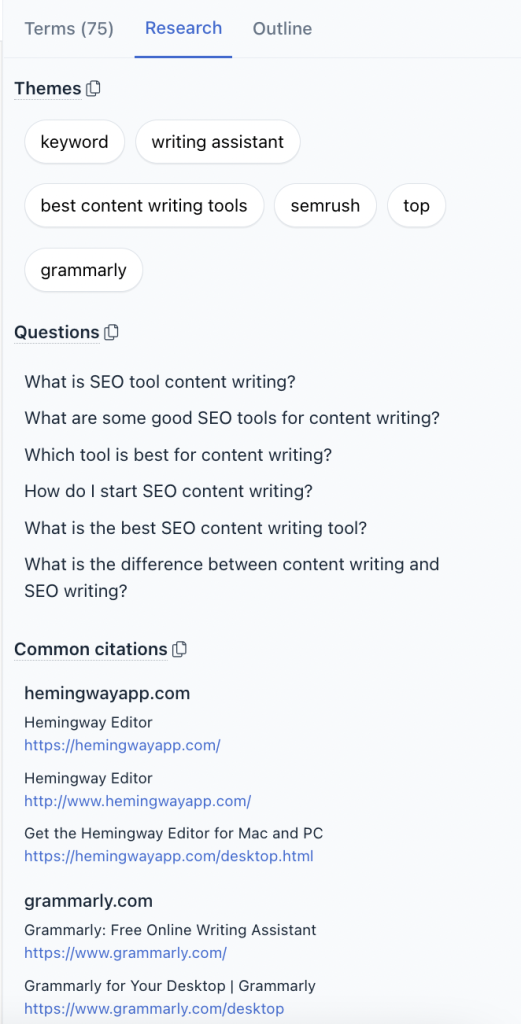
If you’re uncertain about what to prioritize, the Common citations and Themes provide clarity. Use the Outline feature to understand how competitors structure their content and identify essential questions to answer as subheadings.
Clearscope pricing
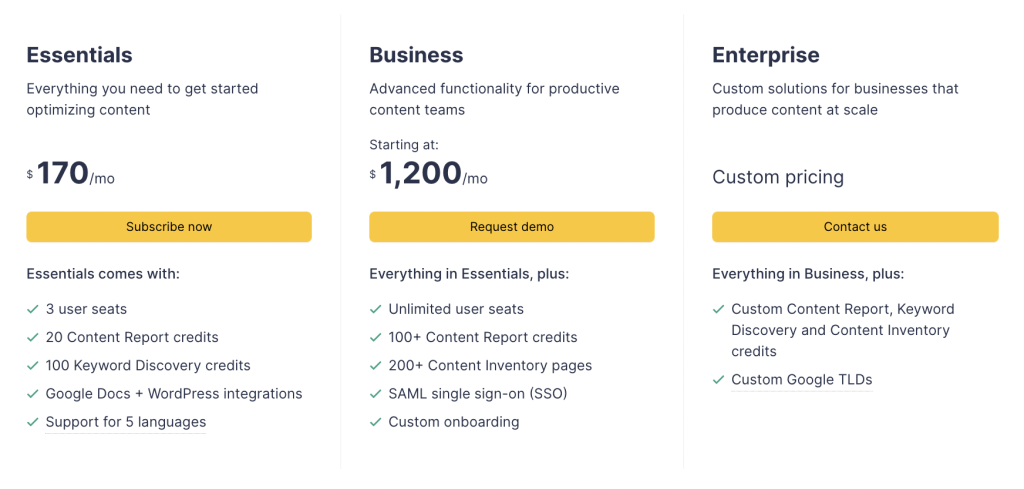
Clearscope offers three plans including Essentials, Business and Enterprise. The Essentials plan is reasonably priced considering the features and is sufficient for small to mid-scale content projects.
Final verdict on Clearscope
Score: 9/10
Standout features: Report
Clearscope has the best content optimization features when compared to other tools with a similar price point. There’s in-depth data to support your content workflow at every stage of the creation process. Clearscope also saves time and eliminates guesswork by showing topics and entities in hierarchical order.
Content Harmony
Content Harmony provides some unique information that I haven’t seen in other content optimization tools. The first step is to create a project and use the primary keyword to get a Content Workflow Report.
Features of the report Include:
Search Intent
The search intent report falls short when compared to tools like Clearscope, MarketMuse, and Semrush.
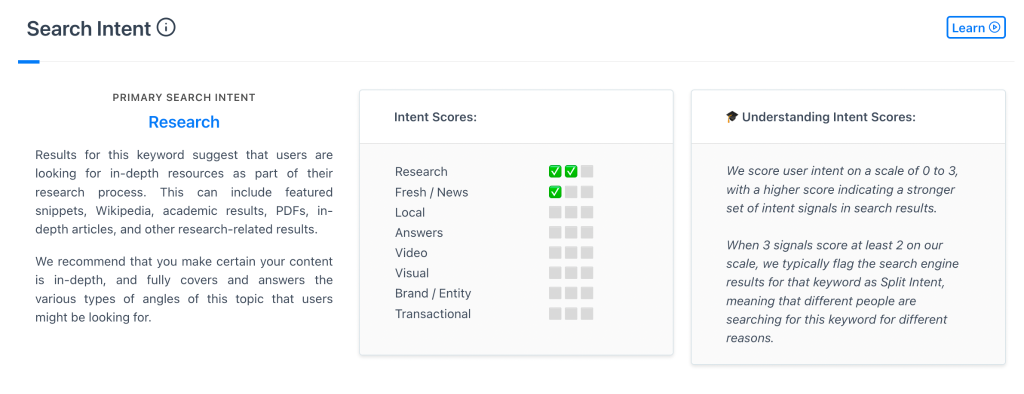
The first section shows the primary search intent for the topic is research but that’s not very helpful because “research” is vague.

SERP Freshness tells you the average age of the content, but how does that help you create better content?
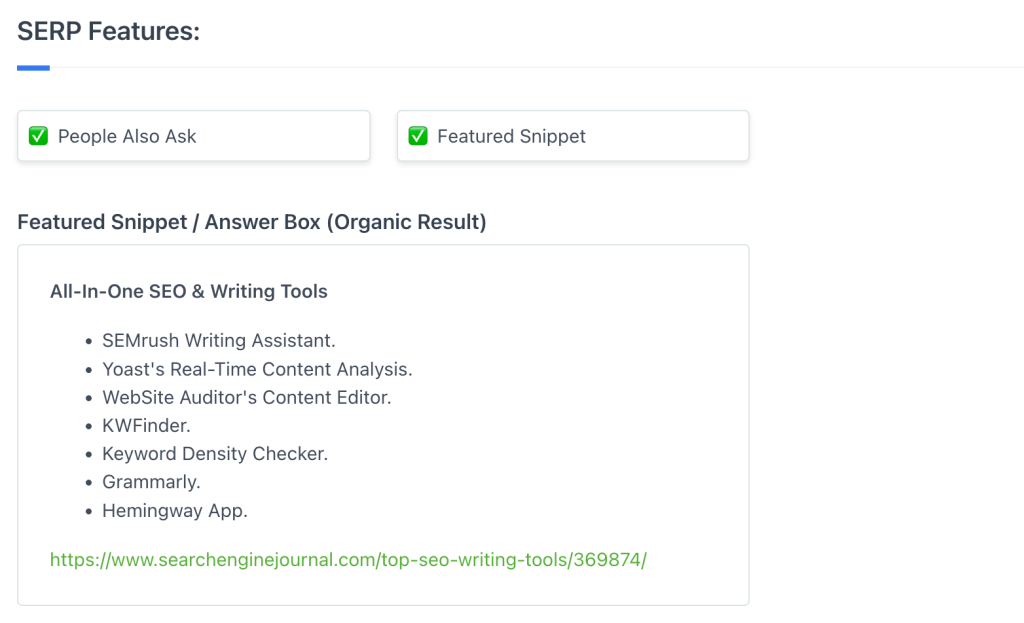
SERP Features show People Also Ask and Featured Snippet, but that’s not the full picture because other SERP features include review (compare) and video.
It’s important that Content tools give you the full picture, so you create the best content that has a chance of ranking.
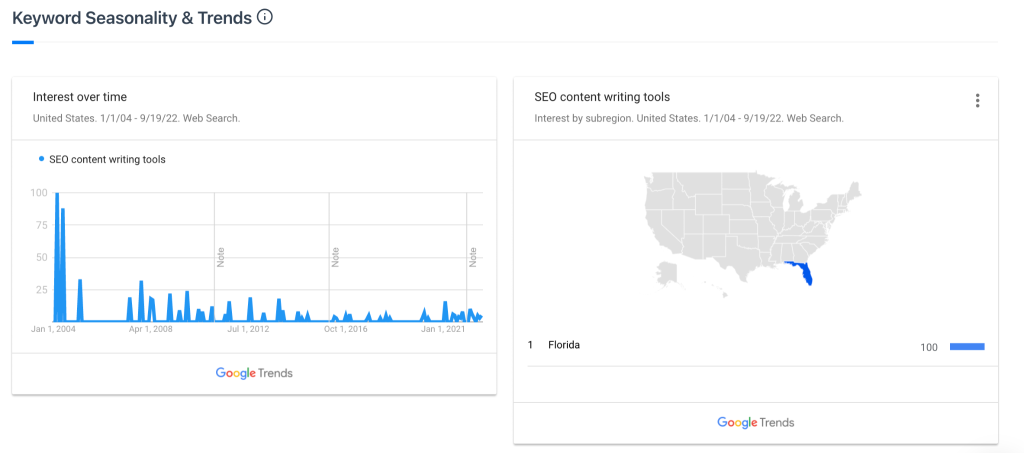
I appreciate the data on Keyword Seasonality, as it helps SEOs who work in seasonal industries to identify when a keyword is likely to trend based on historical search data.
Topic Analysis
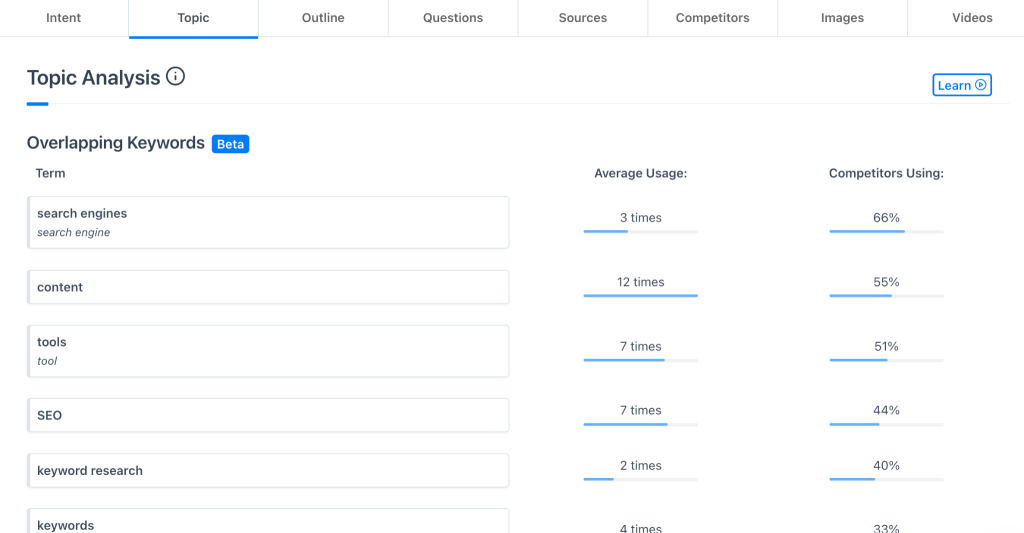
The Topic Analysis is one of the best I’ve seen because it shows average usage and competitor usage for each keyword which serves as a baseline for using SEO topics in your content.
Outline and Questions
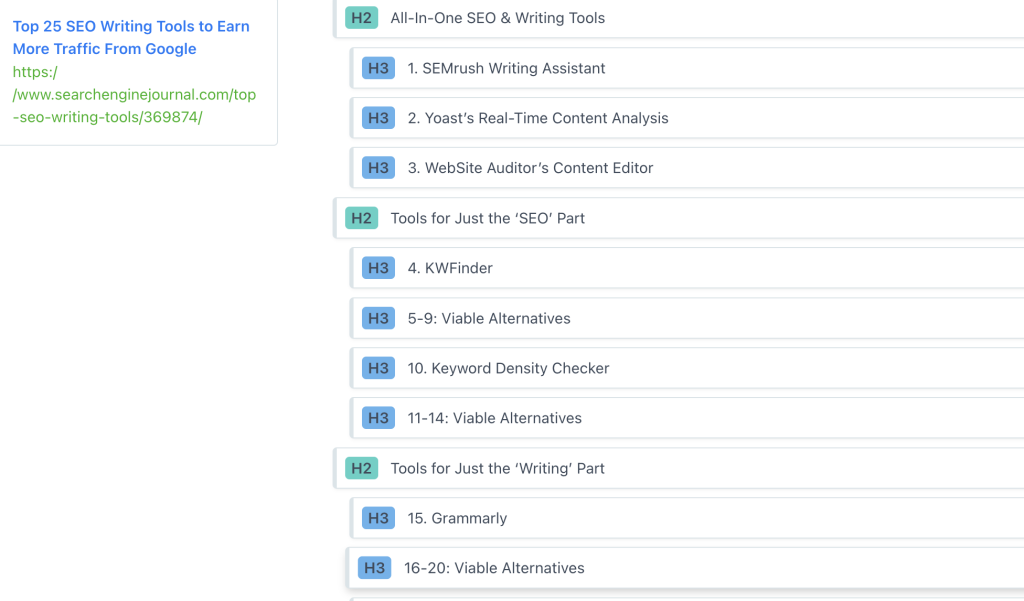
The Outline shows all subheadings for the top 10 SERPs, giving you an overview of how competitors structure their content.
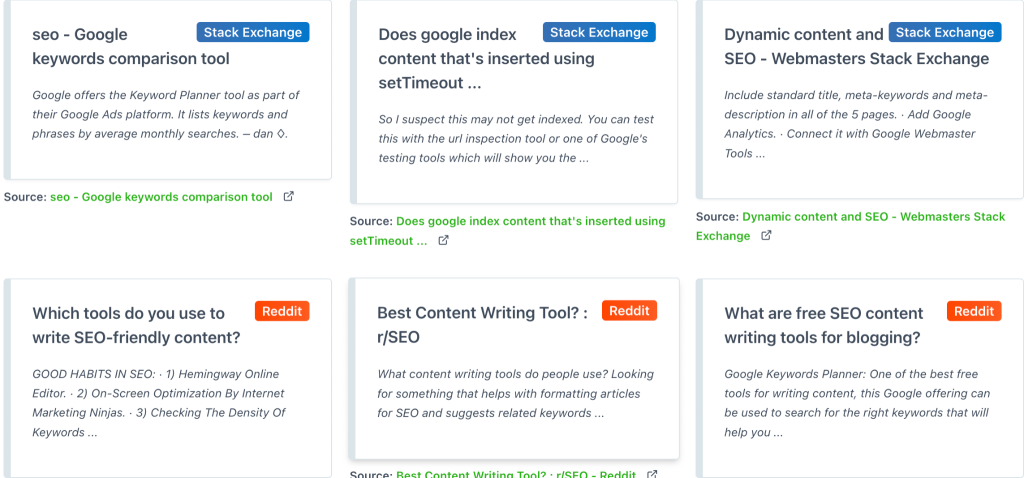
Content Harmony pulls questions from multiple sources including Reddit, Stack Exchange, People Also Ask, and Quora. It’s a brilliant way to understand what your audience already knows about a topic and find missing gaps to close.
Competitors
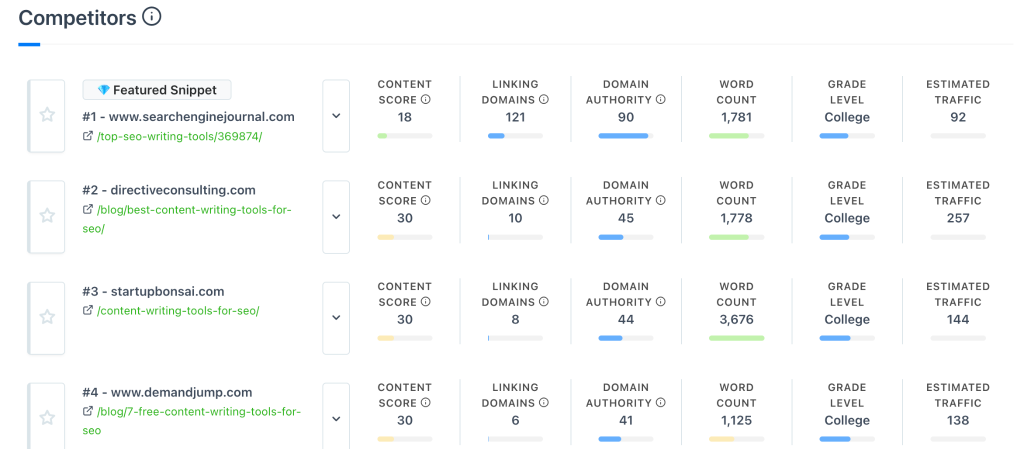
I love the competitor data page on Content Harmony because it shows information such as:
- Reading level
- Estimated monthly traffic
- Content score, and
- The number of domains linking to that page (Moz data)
I can use this data to determine:
- Where to get backlinks
- The ideal reading level and
- Word count for the page
Content Harmony pricing
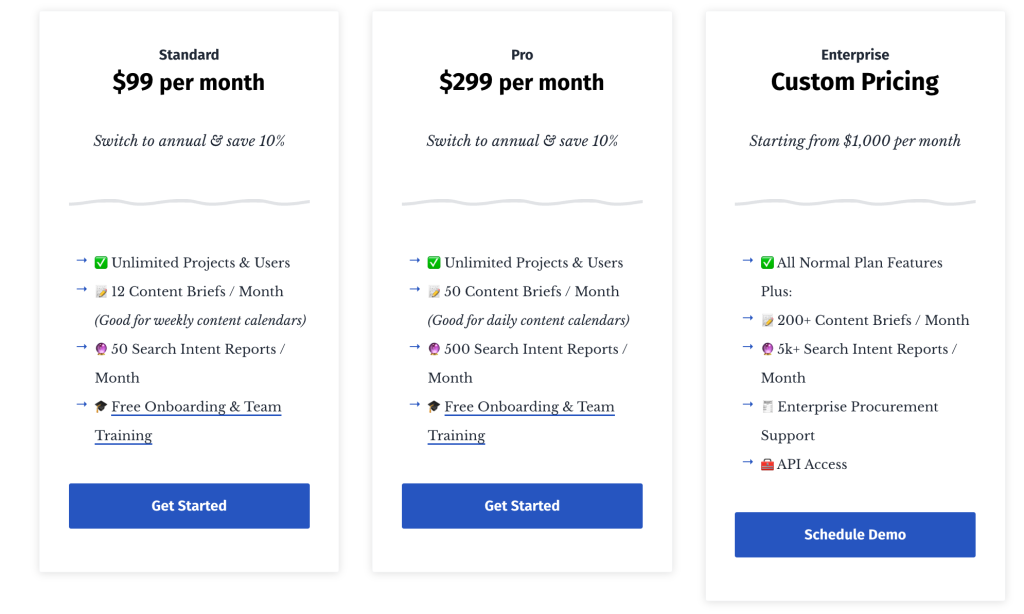
Content Harmony offers three plans including Standard, Pro and Enterprise. The Standard plan is ideal for small projects, the Pro plan is great for mid to large-size projects since it includes 50 content briefs. The Enterprise is ideal for agencies and brands requiring API access.
Final Verdict on Content Harmony
Score: 8/10
Standout features: Topic Analysis, Questions, Image, and Video Analysis (watch the video)
Honorable mentions for Content Optimization tools
- SurferSEO: Great tool for conducting topical research, building content briefs, and optimizing content
- Yoast SEO: On-page optimization recommendations suitable for beginners with zero-level SEO or content experience.
- Page Optimizer Pro: Improve on-page optimization with recommendations from Kyle Roof’s Scientific On-Page SEO Method.
Writing and Editing Tools
Google Docs
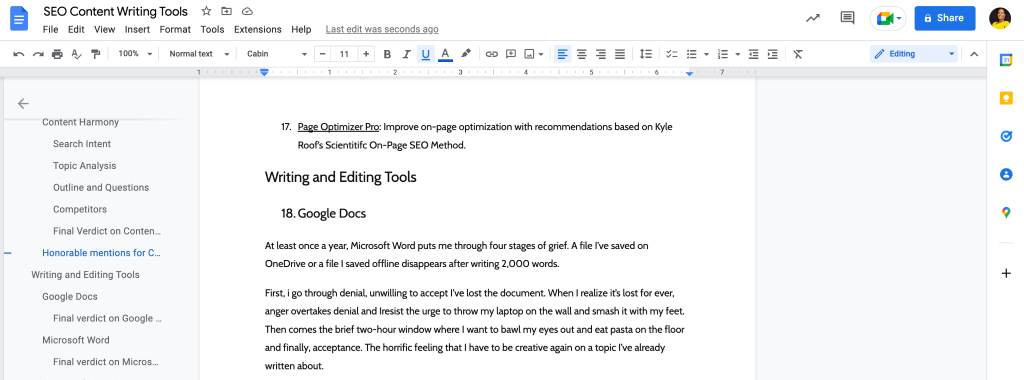
At least once a year, Microsoft Word puts me through four stages of grief. A file I’ve saved offline or on OneDrive disappears after writing 2,000 words.
First, I go through denial, unwilling to accept I’ve lost the document. When I realize it’s lost forever, anger overtakes denial and I resist the urge to throw my laptop on the wall and smash it with my feet. Then comes the brief two-hour window where I want to bawl my eyes out and eat pasta on the floor and finally, acceptance. The horrific feeling that I have to recreate content I’ve already written.
I have never lost a file on Google Docs. I create a document in Google Drive, save it with a name before I start writing and Google Drive automatically updates my work as I go. It has never put me through grief or made me fear losing my precious documents. Where Microsoft Word is fickle and unstable, Google Docs is reliable.
I’ll be honest, I only started using Google Docs to write when I got a second computer because it takes up screen space. But I enjoy using Google Documents for the clean UI, ease of adoption, and collaborative qualities. Google Docs is free if you have a Gmail or Google Workspace account, and it saves your files on Google Drive.
Top features of Google Docs include:
- Dictionary
- Voice typing
- Writing
- Collaboration
- Add-ons such as Semrush, Frase and NeuralText
- Translation
- Download options including PDF, Microsoft Word, and Plain Text
Final verdict on Google Doc
Score: 8/10
Great resource for writing and collaborating without fear of losing saved documents. However, Microsoft Word has more customization options which I look forward to seeing on Google Docs someday.
Microsoft Word
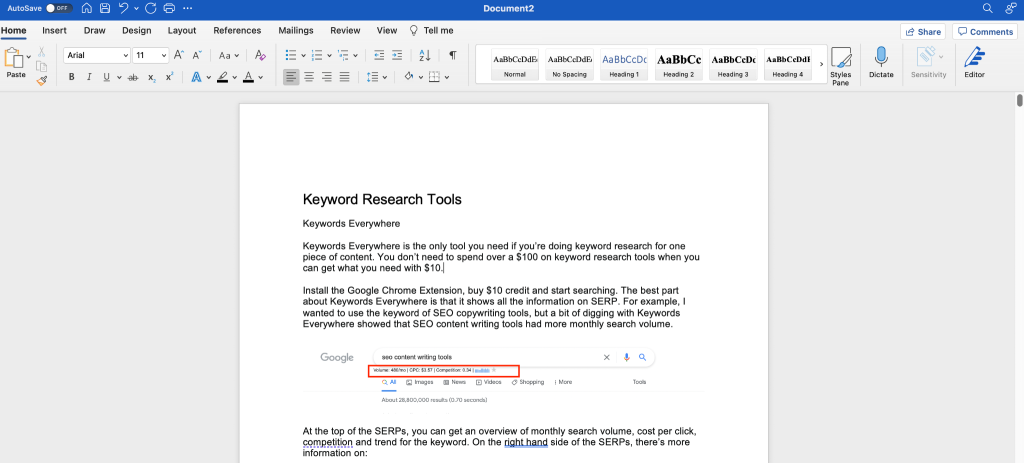
If you like living on the edge and you don’t mind the anguish from losing your documents to unknown forces, then Microsoft Word is for you. While MS Word has more editing and formatting capabilities as an offline tool, I will never forgive them for the documents I’ve lost and grieved for over the past six years. Google Docs is free, and it is a near-perfect replacement for MS Word in my opinion.
Final verdict on Microsoft Word
Score: 6/10
Pettiness aside, Microsoft Word is a decent option if you prefer writing offline and need more editing functionality than Google Docs. MS Word is part of Microsoft 365 which cost $9.99 per month.
Grammarly Premium
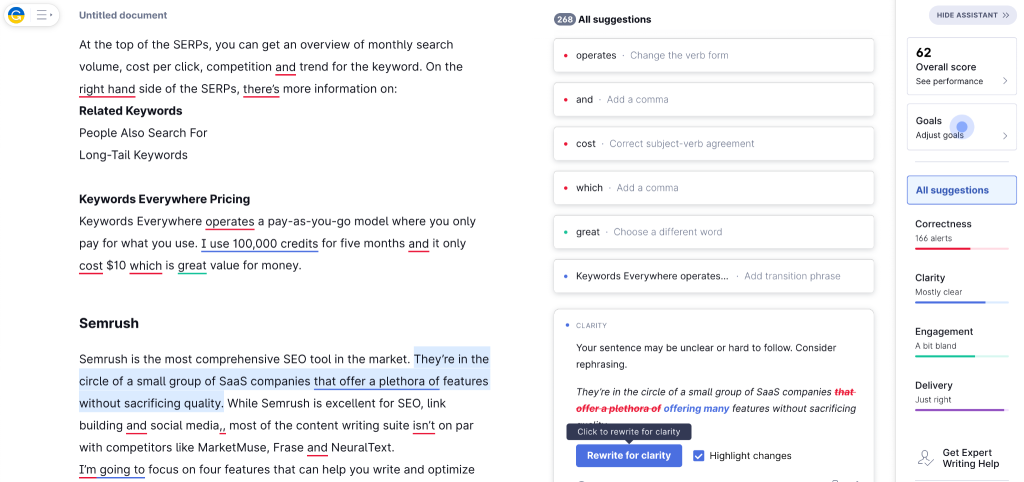
I have never seen a tool as obsessed with the Oxford comma as Grammarly. While this self-editing tool helps you clean up your writing, it’s not a replacement for a human editor as you’ll see from the recommendations they provide.
The free version of Grammarly is good for correcting spelling and grammar mistakes. However, I would advise subscribing to Grammarly’s annual plan for advanced suggestions on tone adjustment and sentence rewrites.

The best part about Grammarly Premium is the Google Doc integration which makes my life easier.
Final verdict on Grammarly Premium
Score: 9/10
Grammarly does a great job as the first step of self-editing your work before sending it off to a human editor. I’ve learned a lot about sentence structure and common grammar mistakes from following Grammarly’s recommendations.
Grammarly pricing starts at $12 per month for the Premium plan and $15 per month for the Business plan.
Hemmingway App
I am not a fan of Hemingway Editor because it over-edits and causes writing to lose human touch. Sentence flow is an important part of writing and if we lose that to AI editing, then we’re no better than robots.
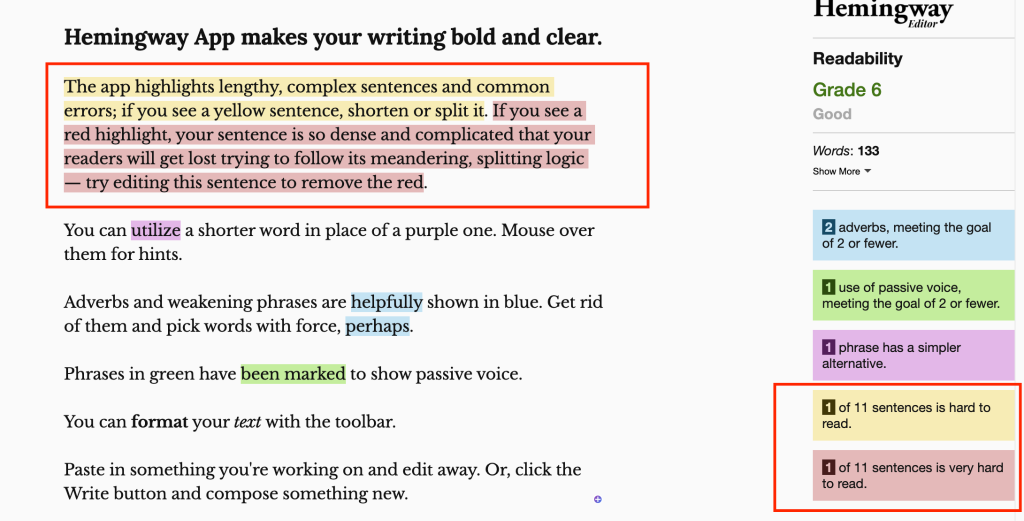
However, I use Hemingway App to identify and rewrite hard-to-read sentences that might affect the flow of the article.
Score: 5/10
Copyscape
Copyscape helps you write plagiarism-free content by running your text against the entire web to check for duplicate content. There’s nothing else on the market that comes close to Copyscape as a plagiarism checker and it’s an essential tool for writers and content managers.
To use Copyscape Premium, paste written text in the box and it checks your content for plagiarism.
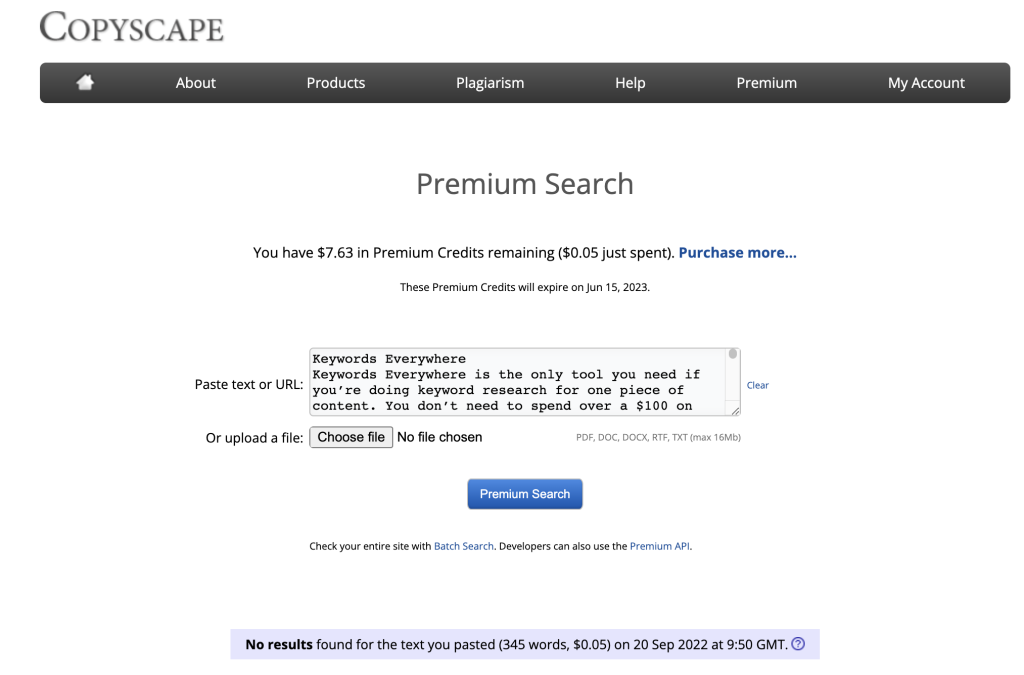
If there’s duplicate text, you’ll have the opportunity to see the exact words copied from existing content.

$10 worth of Copyscape credit can last a couple of months if you’re a freelance content writer and $30 can last a month for writing teams.
Score: 10/10
My final recommendations for SEO content tools
Keyword research: Keywords Everywhere for one-off projects and Semrush for larger projects.
Content Brief and Optimization: MarketMuse, Clearscope or Frase in order of most expensive (and best-in-class) to least expensive
Writing: Google Doc
Editing: Human editor
Plagiarism check: Copyscape
SEO content writing tools improve your workflow but they can’t get you to the finish line
Content tools help to automate workflow, remove guesswork in data and improve optimization. However, tools can’t replace humans because they don’t have empathy or a personal connection with the problem. Don’t rely on SEO content tools to complete the entire cycle from planning to distribution. Instead, use them to support your workflow and achieve content marketing goals.
Need a content writer or strategist?
I help SaaS companies to rank for competitive keywords by building topic clusters and executing as long-form content pieces. Get in touch to set up a meeting






Thx!
Hello Chima, thank you very much for this article.
Hi Diamaka,
I’m glad you enjoyed reading this piece
Chima, this is such a great article. Perfectly detailed and covers all stages of content writing. Helped me find Market Muse and also was a good refresher. Thanks for sharing 🙂
I’m so glad to hear it was useful for you, Kanika
That is a cracking article & I have taken quite a bit from it – Keywords everywhere I didn’t realise was so comprehensive when you add a bit of $ it. One omission I thought of is SEOSurfer which I would put ahead of MarketMuse (I have both)…Cheers! – Nigel
Thank you, Nigel
I’ve used SurferSEO, marketmuse and Frase over the years, but I guess it’s a matter of personal preference at the end of the day